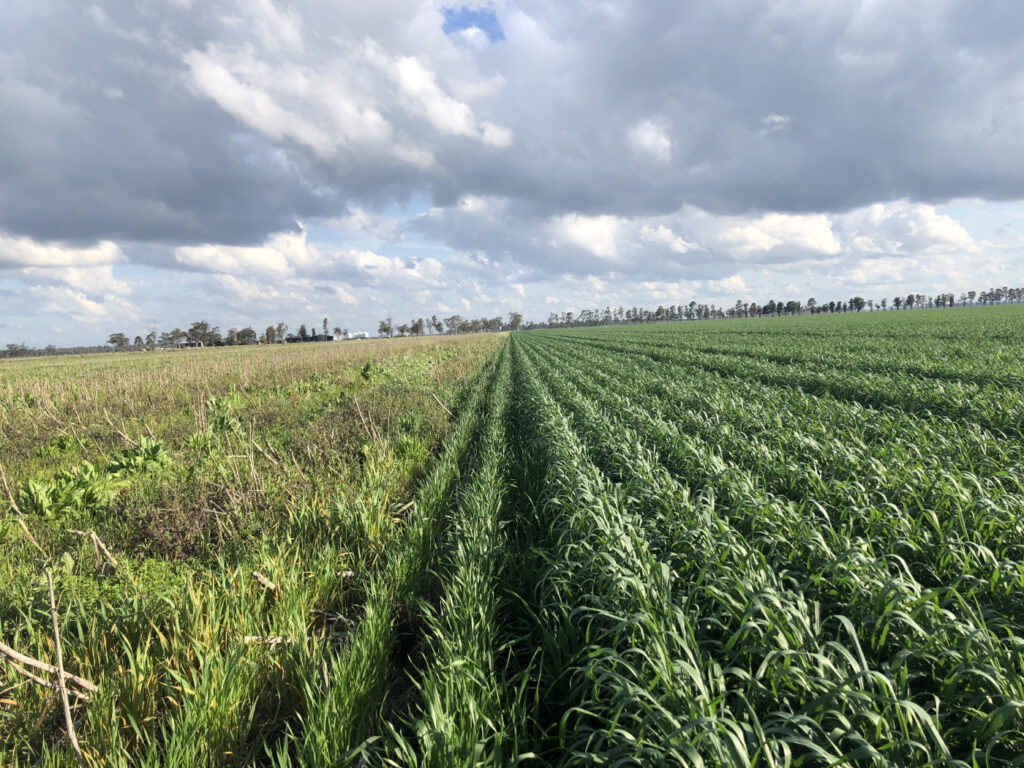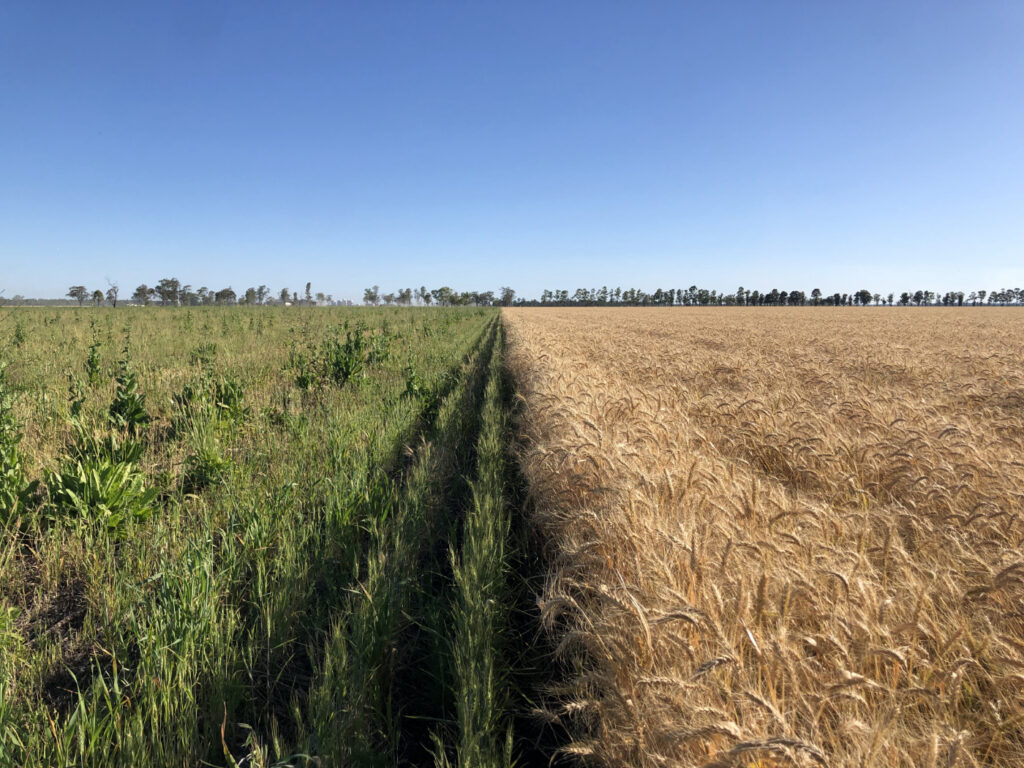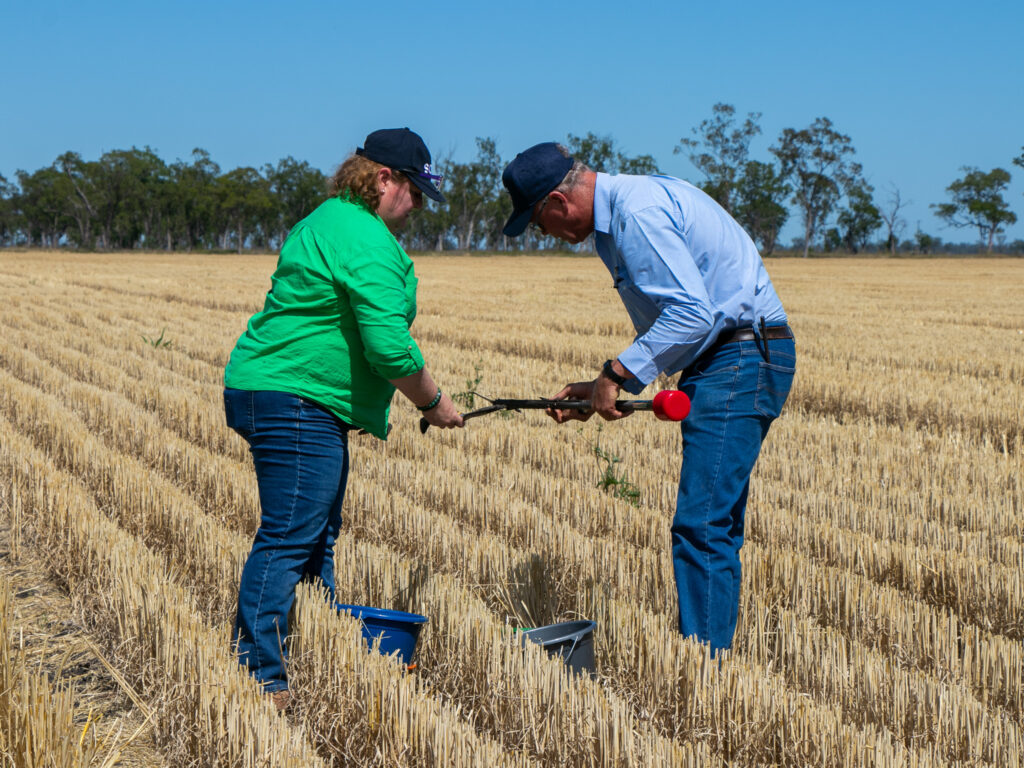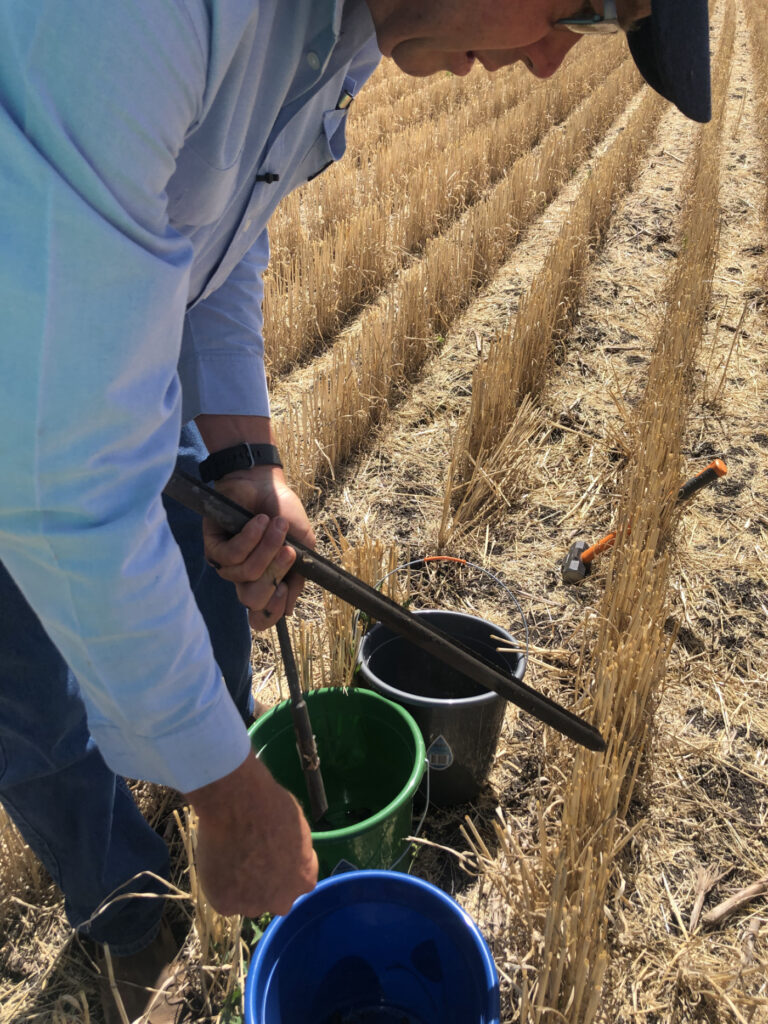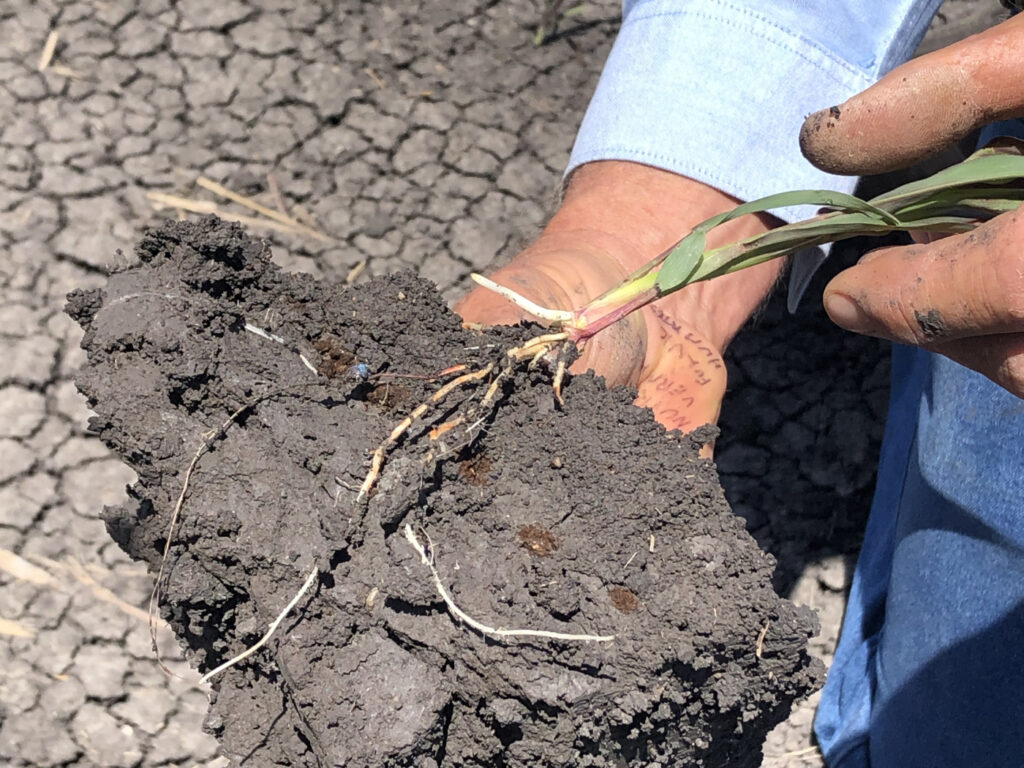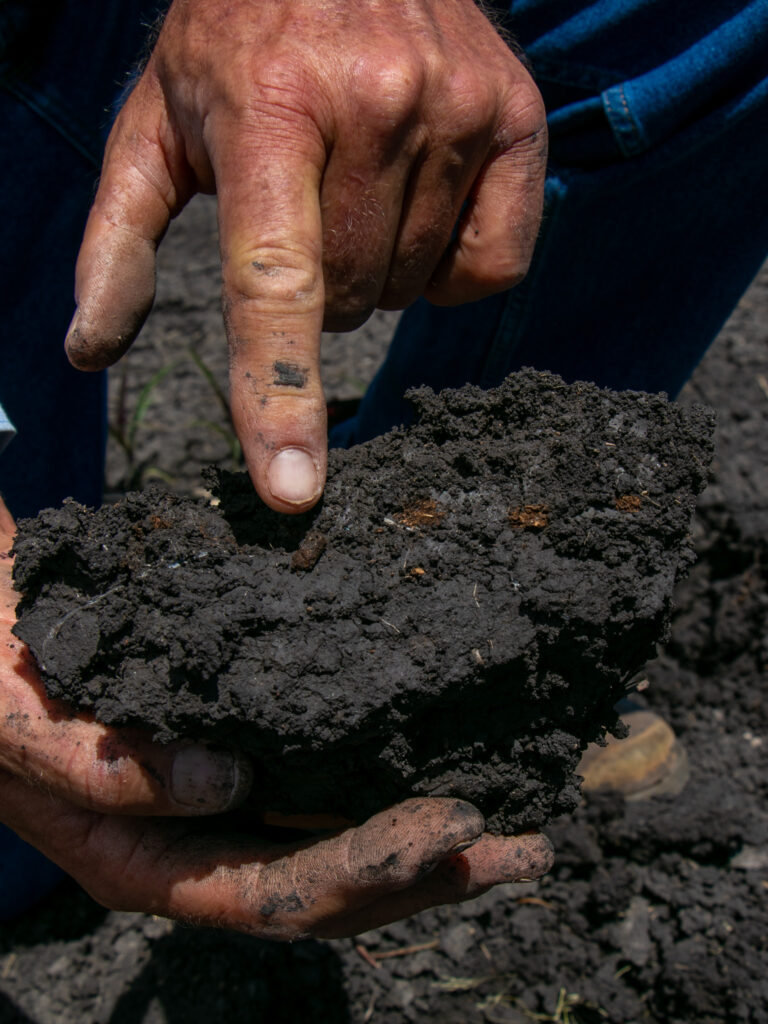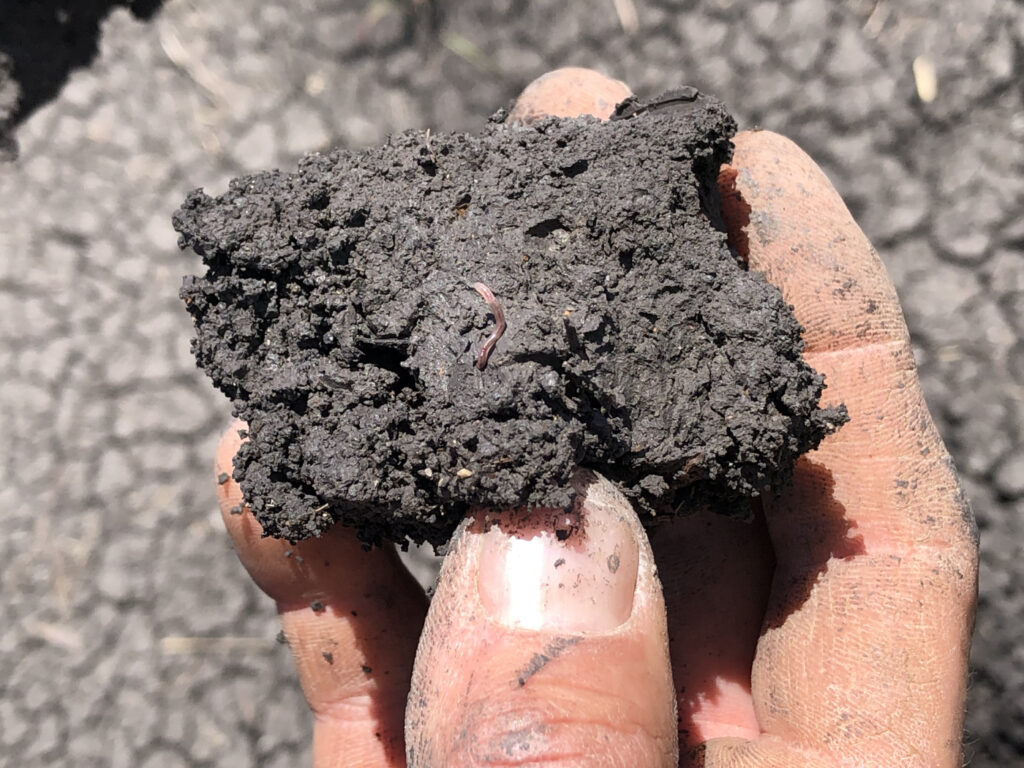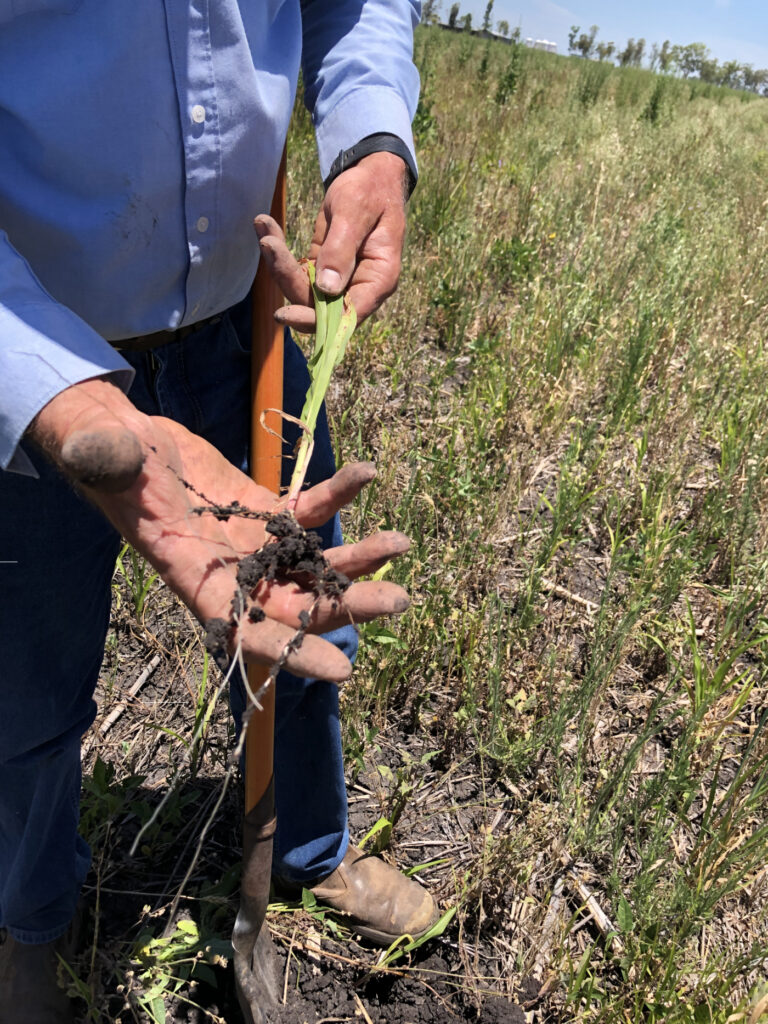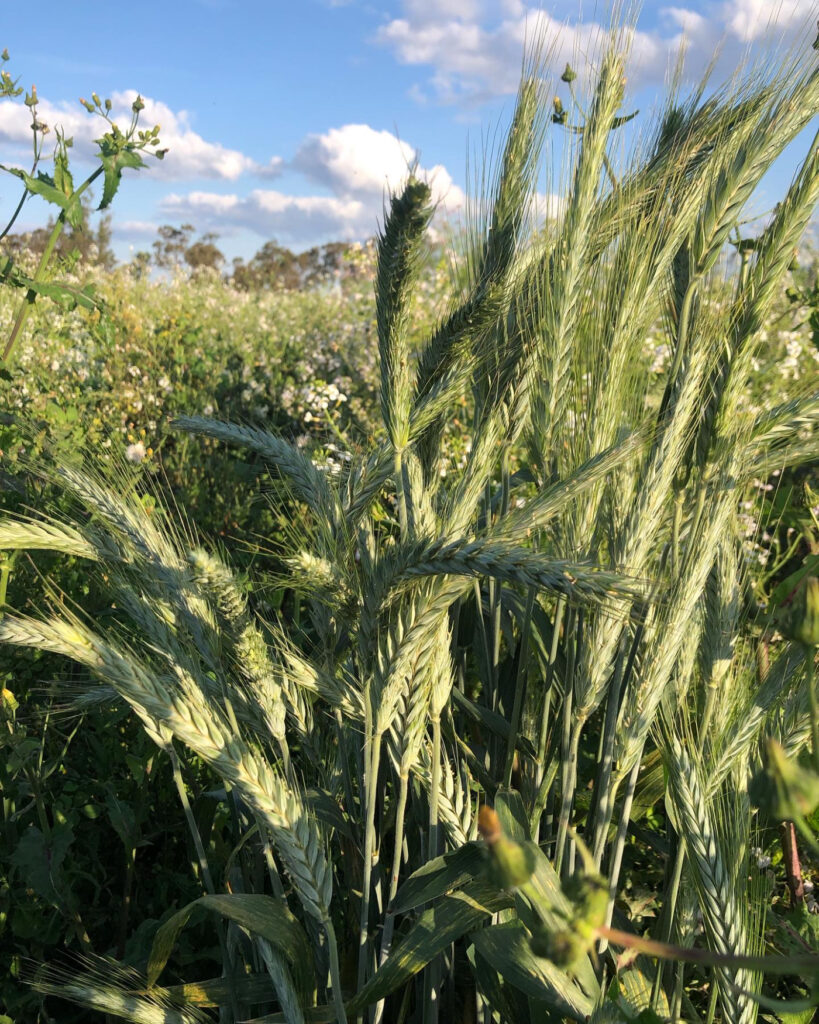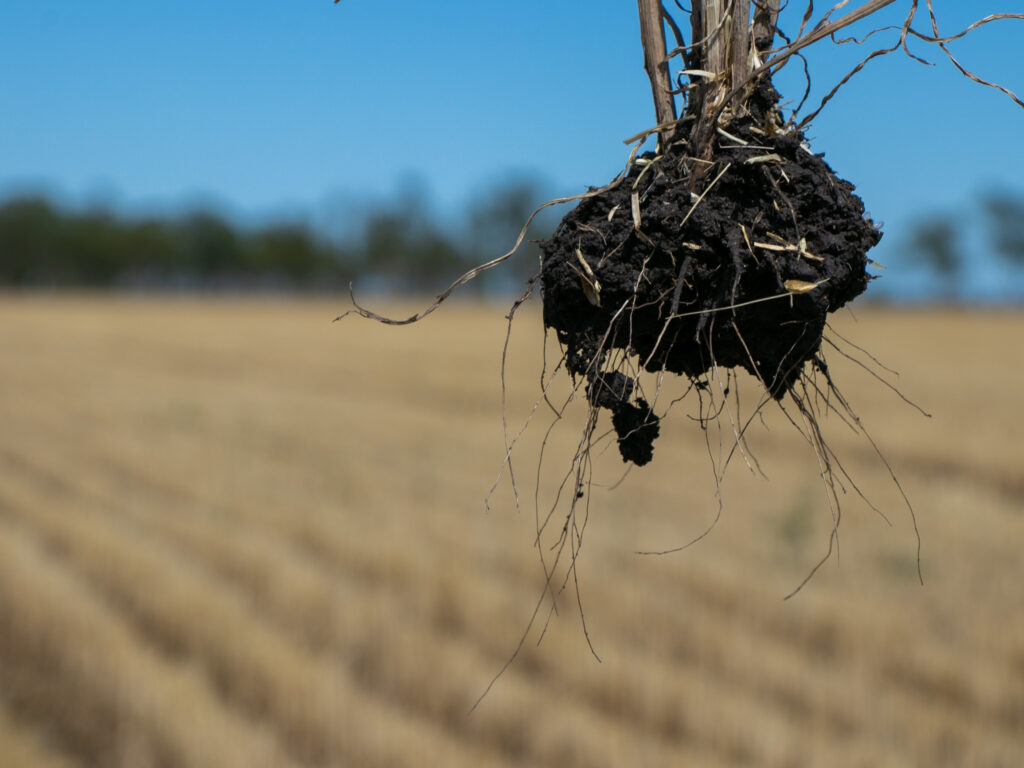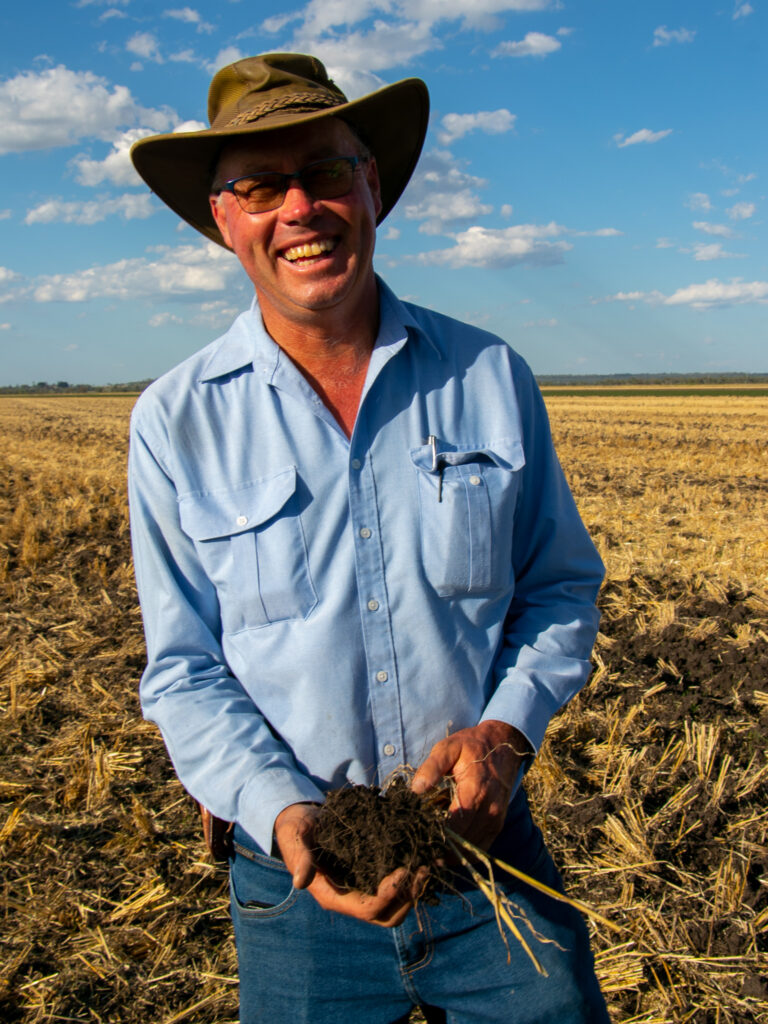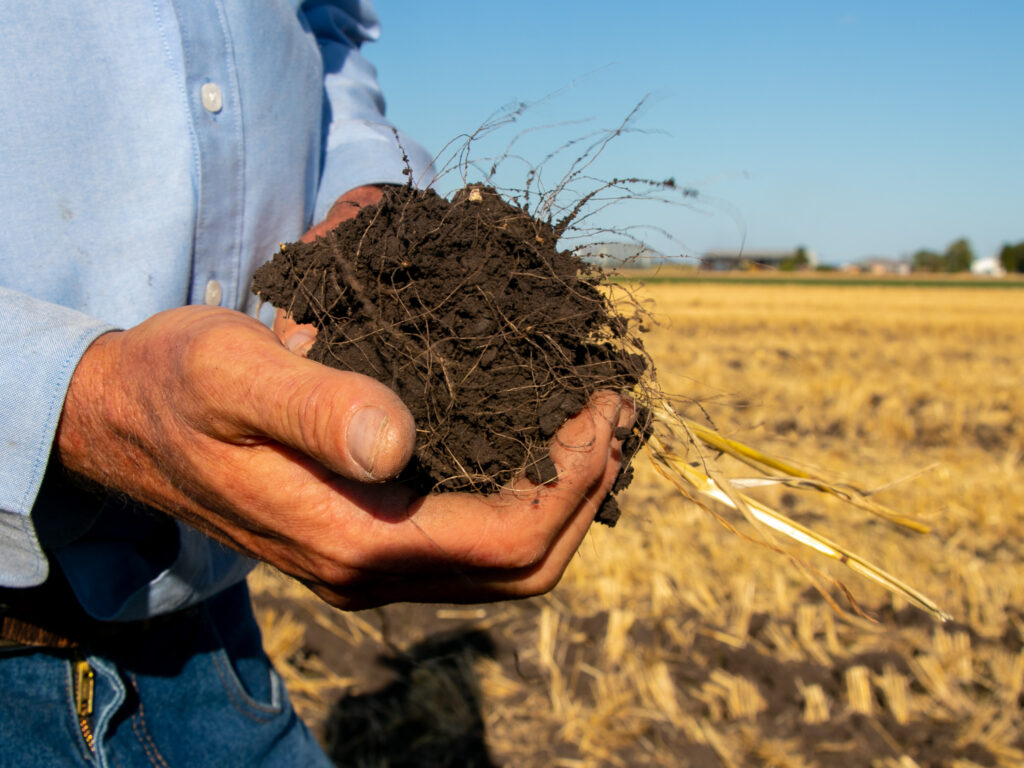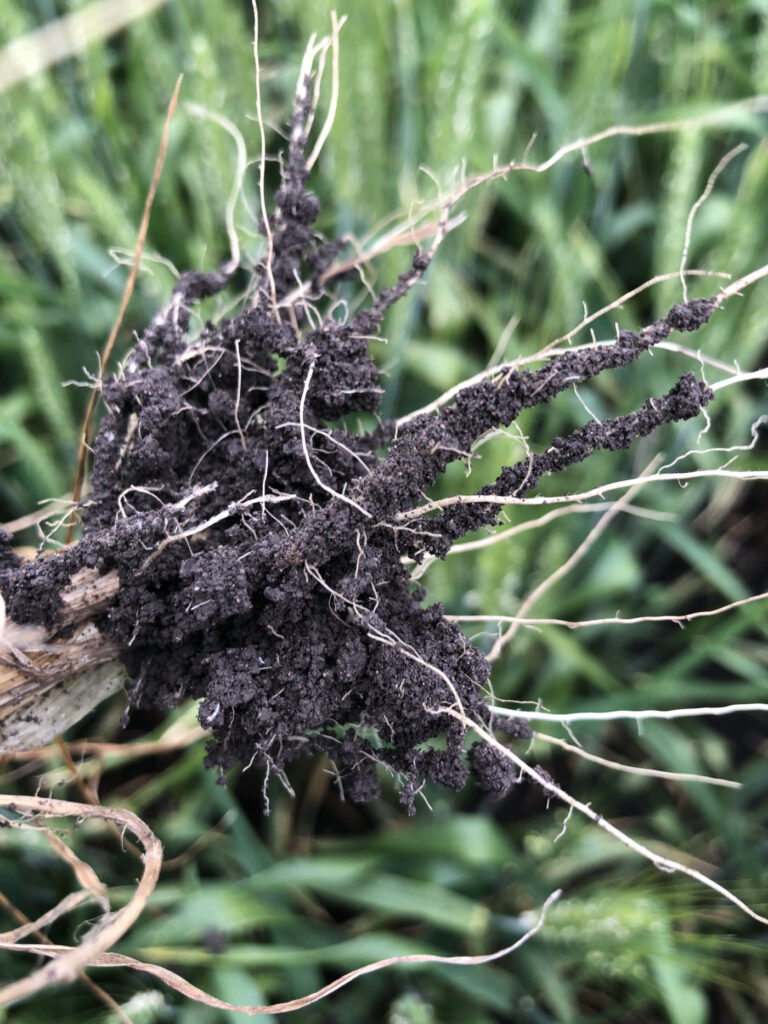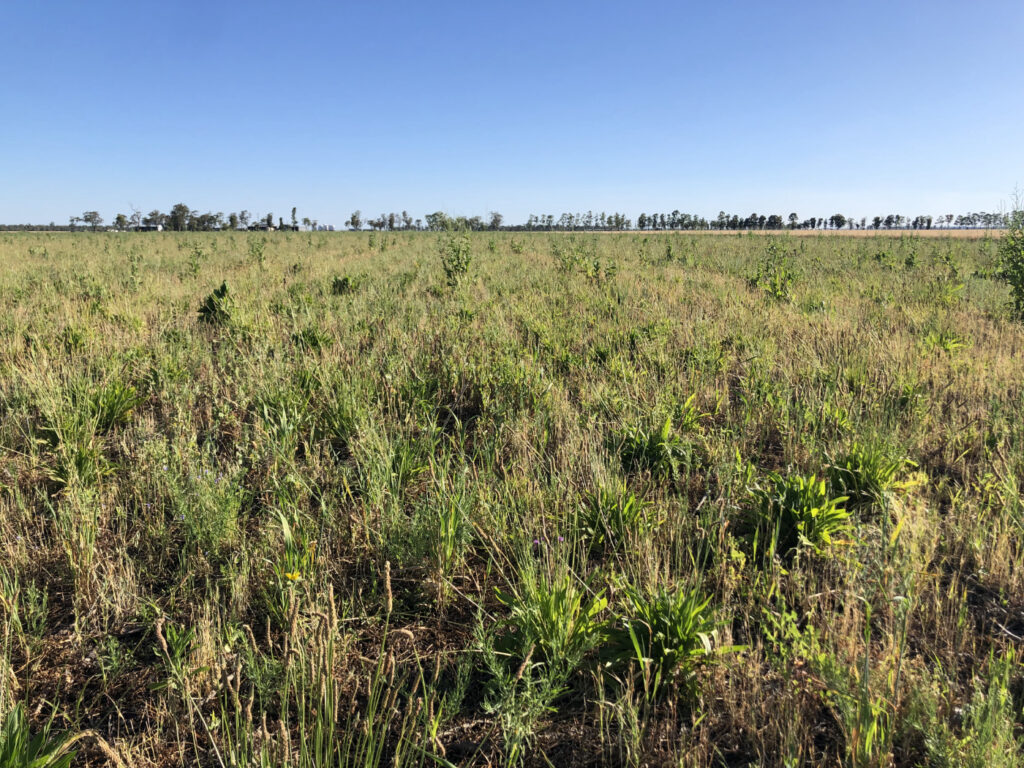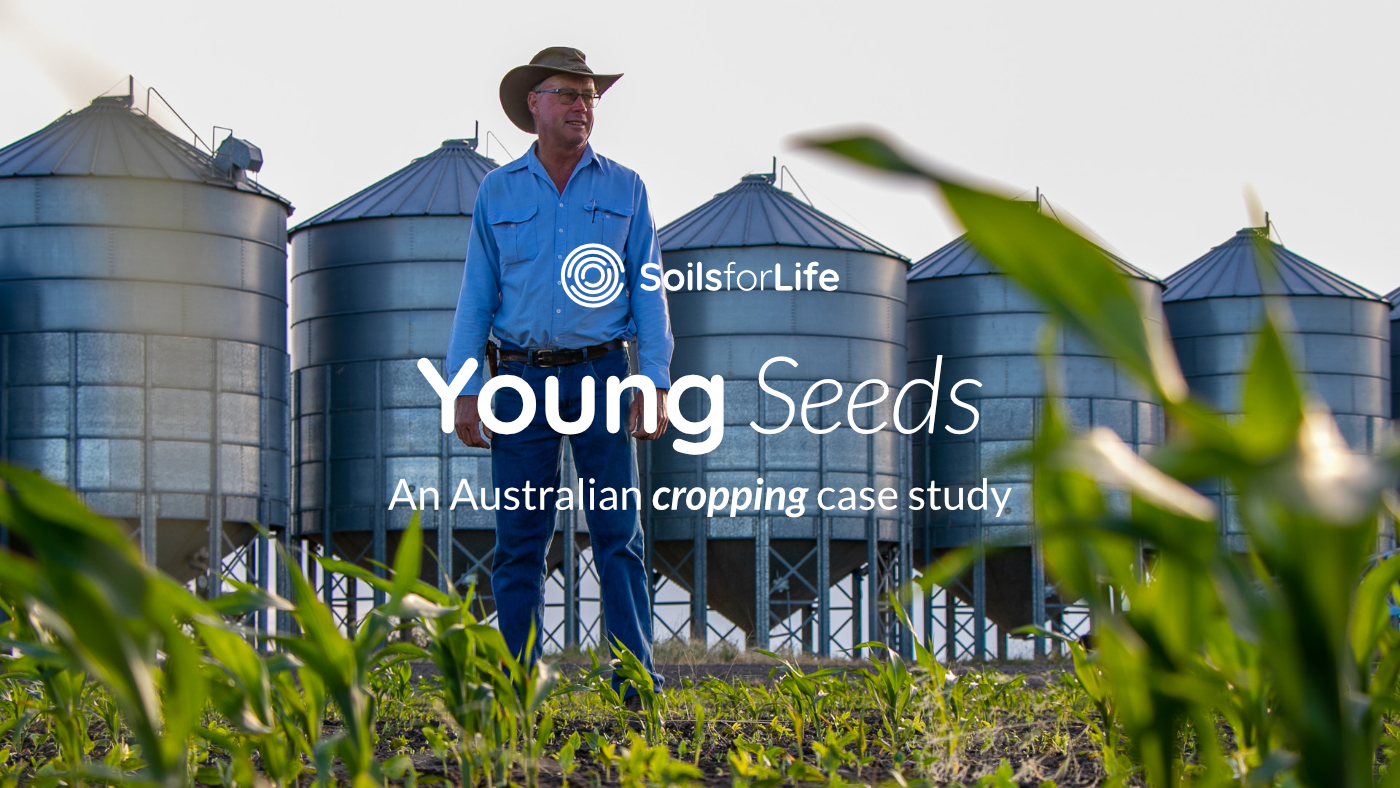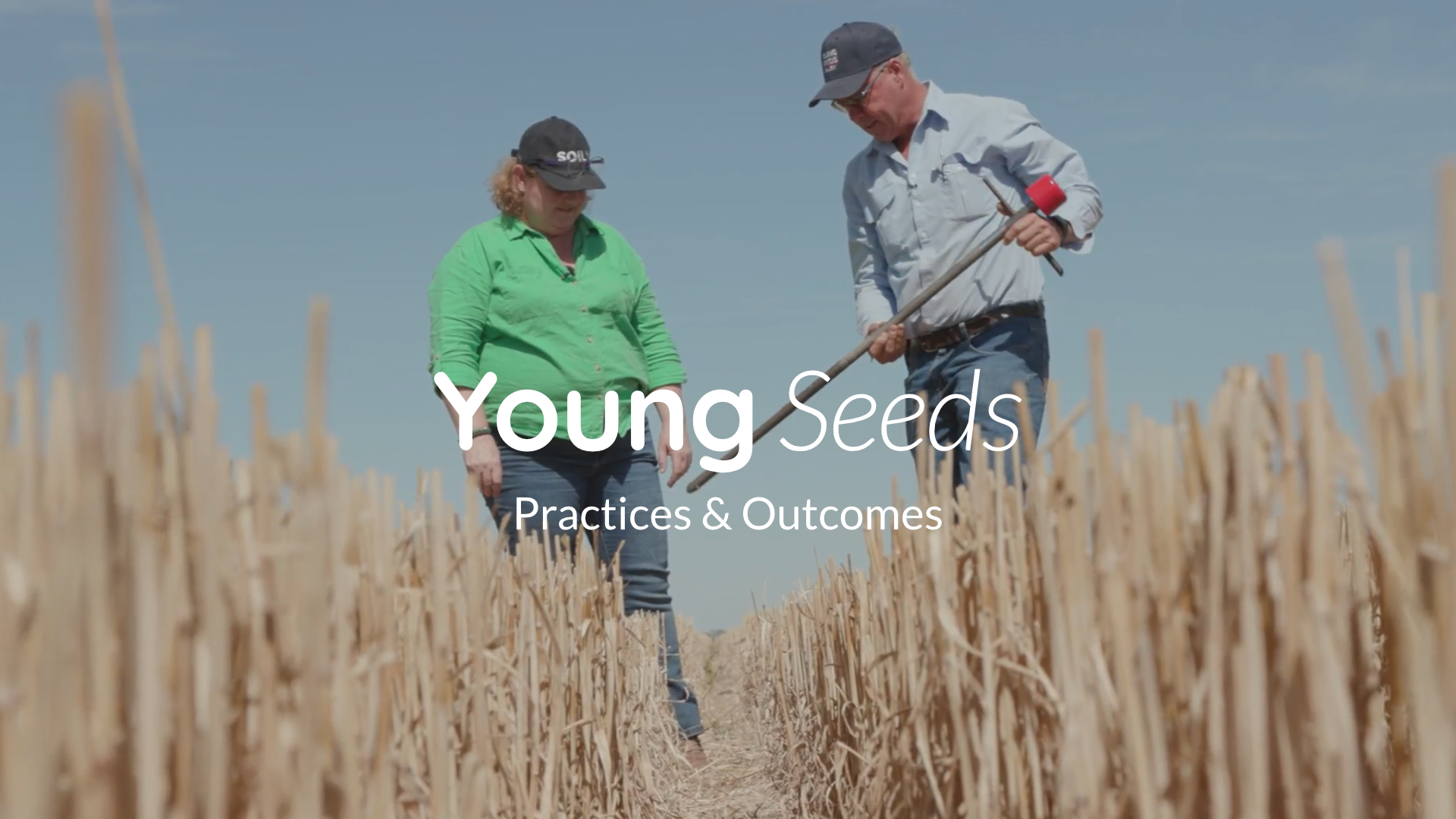Russell Youngs at Young Seeds
An Australian CROPPING CASE STUDY | Updated August 2023
Russell Young’s farming story illustrates how farmers can integrate new practices into well-established farming routines. This story also offers insights into flood prone landscapes like the Condamine River region, highlighting some of the challenges for farmers who have been affected by unpredictable and extreme weather conditions in recent years.
Russell Young was born and raised on the family farm, which his grandfather established in the 1950s. After leaving school, Russell got involved with the property, but for many years divided his time between truck-driving and farming. He has recently come back to farming almost full-time.
In 2017, Russell began exploring new practices on the Youngs’ property. Russell wanted to address compaction issues, moisture storage and waterlogging, and to explore holistic approaches to weed management. He also became concerned about the impact of chemical use to his farming land, and more generally within the food system.
Wanting to explore what his family could do to ‘take more control back over their business, the farm’s health, and family’s health,’ Russell listened to leaders in regenerative agriculture and participated in a soil biology course. These initial actions inspired Russell to trial different approaches to well-established practices on the property, including routine fertiliser and herbicide applications on the farm.
At Young Seeds, exploring and testing new methods and integrating practices with a staged approach has been working well. Russell began a series of trials on a 17 ha intensive regenerative zone in 2021, experimenting with multispecies crops, soil health applications and companion cropping. From winter 2021 onwards, Russell planted a 12-way mix of multispecies, with a summer mix in 2021-2022 including a cash crop component. Over the past five years, Russell has reduced and modified herbicide use, adding biological products that help efficacy and support weed control through building up soil health.
While still in the early days of changes to practice, Russell has observed promising changes in how the soil is behaving, especially in his multispecies paddocks. These results have given Russell a lot of confidence. Looking ahead, Russell wants to see dollar value for nutritional content of regeneratively grown products. He hopes to be value-adding to all of his seed and selling in smaller ratios when the dollar value for that offering exceeds the standard dollar value of his current product.
Farm Facts
Location
Barunggam Country | Western Downs Region, QLD
Climate
Hot dry summer, cold winter
Average Annual Rainfall
598 mm (Dalby, 1993-2022)
Agro-ecological Region
Sub-tropical sub-humid
Property Size
872 ha (total); Barellan (330 ha); Wysall Park (283 ha); Avoca (259 ha)
Elevation
344 m (Dalby)
Social Structure
Family owned and operated
Enterprise Type
Grain and pulses (sorghum, sugar drip, cowpea, chickpea, butterfly pea, pearl and siberian millet, wheat, barley) sold into commodity markets, plus value-add seed production.
Growing Region
Northern (South East Queensland sub-region)
Landscape
Condamine River flood plain with low sandy rises and banks, separated by flats and depressions (Barellan and Wysall Park), and the very gently sloping flood plains of Jimbour and Cattle Creek (tributaries of the Condamine River)
Soils
Black and grey cracking clays (Barellan and Wysall Park) and black self-mulching cracking clays (Avoca) classified as Vertosols1 According to The Australian Soil Classification (Isbell and NCST, 2021)..
*Learn more about soil classifications at Soil Science Australia
Videos
The Highlights
Practices and Innovations
Helpful Strategies
Indicators of Progress
- Trialling multispecies and companion cropping
- Experimenting with seed mixes in multispecies cropping
- Reducing tillage and becoming more mindful of when and how it is used
- Reducing applications of herbicide and modifying pesticide use
- Experimenting with bio-amendments
- Improving soil health to reduce impact of extreme weather events.
- Find points of inspiration and learn from others
- Keep experimenting but be pragmatic and build on solid evidence
- Be honest about the time involved in practice change and incorporate this understanding into your approach to avoid frustrations
- Respect inherited farming legacies while making changes
- A supportive regenerative farming coach can build confidence and a vision for operations
- Test and observe practice change over time with intensive trial sites on farm
- Make the change process convenient, accessible and easily observable, so that it fits the needs of individual farmers.
- Bringing more nitrogen into the soil through holistic practice changes
- Building organic matter into soils, even in times of drought and floods
- Working with water, moisture and extreme rainfall in a holistic, systems-led way
Cropping landscape and soils
About the landscape
The Young Seeds properties are located in the Western Downs region of South-east Queensland on the Central Darling Downs. The landscape surrounding Barellan and Wysall Park (south of Dalby) is described as alluvial plains (river floodplain deposits) of mixed basaltic and sandstone origin.
The landscape surrounding Avoca (north of Dalby) is described as older alluvial plains of basaltic origin (Harris et al., 1999). These alluvial plains are associated with the Condamine River (Barellan and Wysall Park) and Jimbour Creek and Cattle Creek (Avoca), which are tributaries of the Condamine River.

Figure 1. Satellite image marking Young Seeds farming properties: Avoca, Barellan & Wysall Park. Source: Soils for Life.
The subtropical climate of the Western Downs is variable with high evaporation rates, frosts and heatwaves. Annual average temperatures range from 12.6°C to 26.7°C (1992-2022) and strongly influence land management (Harris et al., 1999). Most of the average annual rainfall (598 mm) tends to fall during summer, however, more frequent and intense rainfall events have become more common in recent decades (R. Young, personal communication, 2022).
Like many land areas under agriculture across Australia, the vegetation of the Western Downs has been impacted by agriculture, ranging from the extensive clearing of trees, to the modifying of the natural grasslands. At Barellan and Wysall, the vegetation includes poplar box (habitat for tree-dwelling mammals, birds, and Koalas) and Queensland blue gum open woodland (habitat for tree-dwelling mammals and birds) and grassland. At Avoca, the historically dominant grasslands of Queensland blue grass are registered as endangered.
About the soils
The soils at Barellan and Wysall Park are mapped as belonging to the Recent Alluvial Plains Land Resource Area (LRA), and include black and grey cracking clays (Vertosols) and sands or loams over brown or black sodic clays (Sodosols (Figure 2, right). The most common soils of this LRA are the Condamine (fine self-mulching clay), Haslemere (texture-contrast sand or loam over sodic clays), Mywybilla (coarse self-mulching cracking clay), and Anchorfield (deep, self-mulching cracking clay).

Figure 2. The Young Seeds property boundaries with broad soil groups and Land Resource Areas. Source: Soils for Life. Note: The Land Resource Areas represent a regional overview and are not derived from detailed soil information.
At Avoca, the soils are mapped as belonging to the Older Alluvial Plains LRA (Figure 2, left). These soils are described as dark brown to black self-mulching clays (Vertosols) and are most likely the Waco soil, described by Harris et al. (1999) as deep to very deep (100-180 cm), fine self-mulching, dark brown cracking clays.
Cracking clays are the main cropping soils of the Central Darling Downs. Prior to intensive cropping, these soils would have been very fertile, friable (easily breaking into a finer crumb structure), and have had high levels of organic matter. After decades of continuous cropping, these soils are significantly less fertile and their once friable soil structure has been degraded by cultivation (Harris et al., 1999).
The most common forms of soil degradation in these soils is soil compaction, hardsetting, and the loss of soil surface structure, leaving them less workable and prone to wind and water erosion. The extent to which these issues occur depends on the soil, including its capacity to store water, and organic matter content.
Generally speaking, the soils at Barellan, Wysall Park and Avoca are highly valued and easily worked, however the workability of the soils will be highly dependent on the climatic conditions. While the soils are able to store summer rains for winter and spring cropping, this perceived benefit may lead to runoff and erosion (particularly of bare soils), and flooding if there are early or significant winter rains.
Russell Young’s story
- Phase 1 - A multi-generational cropping family
- Phase 2 - Learning about soil health
- Phase 3 - Multispecies experiments
- Phase 4 - Evaluating the benefits
A multi-generational cropping family
1950-2016
Young Seeds is a cropping enterprise with a long history. For three generations, the Youngs have farmed in the area, passing down farming routines and sharing local knowledge based on their in-depth observations and experience in the Western Downs region of Queensland. Russell’s father David took over the property from his grandfather in 1976 and Russell started share farming with his dad in 1988.
Family legacies and influences
Three people influenced Russell to explore ways to support soil and landscape health: his grandfather, father and sister. Both of Russell’s grandfathers were farmers and each of them made Russell aware of different paths that farmers can take. Russell doesn’t criticise either man, however, from his own observations over time, he came to realise that certain practices were detrimental to soils and landscapes in the region. Describing differences between his grandfathers’ approach to farming, Russell reflects:
One was manageable, sustainable, continuing things on for multi-generations. The other one, gradually, things were declining, so that was a pretty clear thing for me as a kid growing up.
One of his grandfathers used more conventional farming methods common in the region, including widespread chemical and fertiliser use, and burning and removing stubble. The other, a dairy farmer based in Gympie (QLD), Russell says, ‘was a long way in front of his time.’ In the 1950s and 60s, his grandfather was doing things that are popular now in regenerative agriculture. Russell remembers:
I saw he was into ploughing in green manure crops – the one on the coast – pulled out the pig effluent from his piggery and would spread it on his own country. So, I was aware of more things than just, go to town and get the fertiliser and stick it in the ground.
Russell’s grandfather in Gympie died when Russell was a young boy and his farming legacy was passed down to his father, David. David took over management of what is now known as Young Seeds in 1976, on Russell’s maternal grandfather’s property. As soon as David started farming, he began to alter certain practices.
Russell recalls, ‘in the first couple of years when dad got involved, he started to plough the stubble in, rather than burn it.’ While David was proactive in changing the approach to stubble, Russell says ‘it took quite a few years for there to be enough microbes in the soil to chew up the stubble in a reasonable time-frame.’ David also reduced the amount of fertiliser used on the farm where he was planting legumes, given legumes introduce nitrogen back into soil. When Russell began share farming, he grew legumes for the same reason.
Russell’s parents, David and Leonie continue to live at Barellan and his father is still active on the farm, contributing where he can to the Young Seeds enterprise. Since taking on management, David and Leonie have supported Russell ‘to come in and start to make a few changes’ of his own. Russell and his wife, Leanne, live in nearby Dalby. Leanne is a school teacher and they have two daughters both at school locally. Russell is now responsible for Young Seeds and he has returned to farming almost full-time on the family properties – Avoca and Barellan – covering 589 hectares. In 2022, Russell took over a lease of approximately 283 additional hectares (Wysall Park), which increased management to 872 ha of farming land.
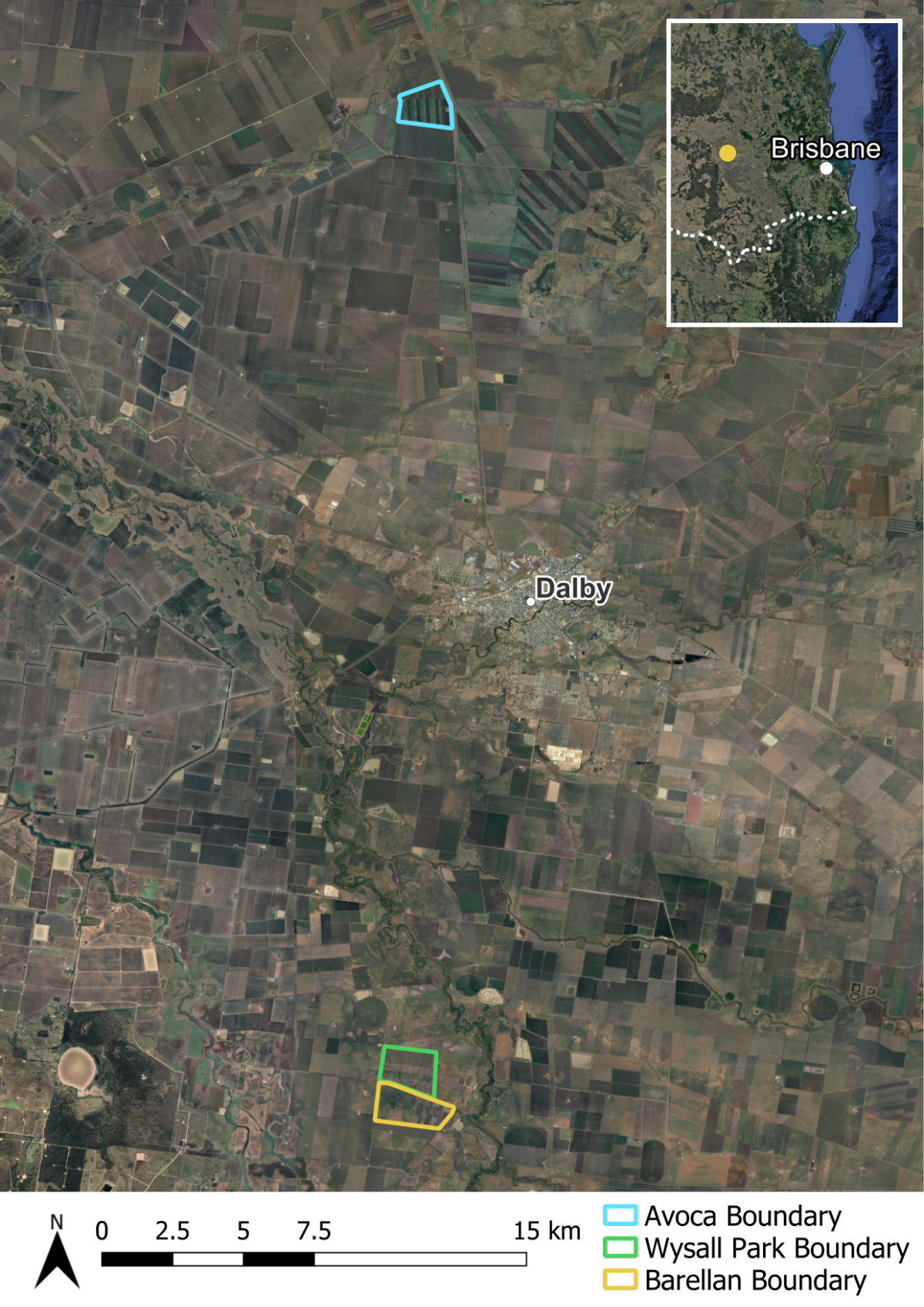
Figure 1. Satellite image marking Young Seeds farming properties: Avoca, Barellan & Wysall Park. Source: Soils for Life.
Changing rainfall patterns
The two properties, Barellan and Wysall Park have always been impacted by flooding from the Condamine River. Avoca is located in an area of two tributaries of the Condamine River – Jimbour Creek and Cattle Creek – which are also prone to flooding. When Russell took over management and began comparing his father’s and grandfather’s farming records with his own observations, he became more aware of the increasing intensity of rainfall in the region, noticing ‘rain is tending to come in shorter, more intense bursts with larger amounts of water.’ Russell has observed certain changes in the intensity of rainfall:
We tend to be getting probably reasonably similar rainfall totals at the end of the year, but we’re getting them in bigger lots […] in a month period we’re copping three months worth of rain, then we’re getting nothing. So, we’re getting bigger totals in smaller time frames.
The change in rainfall patterns and predictability has brought a set of new challenges, including more intense flooding. Flooding and water-logging damages topsoil, and this impacts the management of moisture in both the ‘really dry and really wet periods’ of farming at Young Seeds, making it difficult to crop, particularly things like legumes. They have also experienced extensive moisture loss after heavy rainfalls, with the soil becoming more susceptible to severe drying out and cracking after heavy rains. Russell notes that when ‘our soil type gets excessively wet for a period of time, it tends to dry out really badly on top.’ The Youngs’ approach to cropping has always involved full tillage, but after a major flood event in 2011, Russell became more mindful of the impacts of tillage and he began questioning how it could be reduced. He wanted to better understand how to move and store water more effectively in the flood prone region, and to use all available moisture when they had it.
The impacts of chemicals in seed production
In addition, Russell began to look for alternatives to chemicals. For many years the overall approach to cropping at Young Seeds had involved the application of conventional types of fertilisers and herbicide. Russell didn’t class Young Seeds’ operations as high-level chemical input (in comparison to other farms in the region), but it had been higher than he was comfortable with. After decades of chemical use, Russell felt a growing sense of responsibility as a seed producer to reduce chemical use on the farm. He was uncomfortable using chemicals and felt there must be a better way, saying:
I hate using chemicals. I hate actually physically using them, mixing them, dealing with them, handling that product, and I don’t think it’s particularly good for our environment as well.
His ongoing concerns about the impact of harsh chemicals on human and environmental health, and his concern ‘about what that does to the food chain’ motivated him to learn more about low-chemical and organic farming methods.
Learning about soil health
2017 – 2019
2017 – 2019 were extremely dry years on the farm. Russell wanted to address compaction, waterlogging, reduce chemical inputs, develop effective methods for moisture storage, and experiment with ways to support thriving soil biology. He invested in his own learning and considered how changes to farming practices would benefit the land and his business.
Getting inspired and learning from others
In 2017, Russell began exploring the potential risks and benefits of changes to practice, motivated to ‘get more control over the business and the overall health of the farm.’ He looked into ways to reduce synthetic chemicals and sought new information to help him address challenges they were facing. Russell’s sister Jenny played a part in opening Russell’s mind to pathways for supporting soil and landscape health on the property. After being introduced to Dr Elaine Ingham’s work by his sister, Russell enrolled in a Soil Food Web course, which he completed in 2018 in Lismore, NSW. The course was essential in developing his knowledge and confidence:
You spend three days learning about biology and what it does in the soil. I stayed on and did another three-day course looking through a microscope, you know, to actually be able to identify the little things that are in your compost and that sort of thing. I came away from there realising that as farmers, many of us don’t know too much about what we’re doing in the soil. We can jam stuff in there and we can get it to grow, but what are we doing down there? So that was a catalyst for me to start to look at some changes.
Russell listened to other leaders in regenerative agriculture including Gabe Brown, Joel Williams, Ray Archuleta and Dave Brandt. Learning about soil biology helped him to see that, ‘biology is king and if we don’t have fungi and bacteria in our soil, we are heading down the wrong path.’
Russell knew he wanted to reduce chemical use and reduce tillage. He gained new knowledge about how to improve and stabilise nitrogen in the soil and different ways to lessen the impact of chemicals on the soil biology at Young Seeds, while not decreasing the efficacy of chemical inputs in their weed management. Russell decided that he would experiment by exploring ways to incorporate old and new practices, without ‘jumping ship’ completely. He was reluctant to transition too quickly from his conventional farming practices because he didn’t believe it was possible while running a viable operation. The changes he undertook during this period were done through a staged, strategic process, fitting into the complex logistics of maintaining his existing enterprise.
Feeding the soil with bio-amendments
After completing the Soil Food Web course, Russell experimented with bio-amendments, including compost (down the slot with the seed) and compost teas (applied as liquid injections), to build up and feed soil biology. Russell made his own compost, mixing materials on the property with things he brought in, including feedlot manure, hay and mushroom compost.
Table 1. The range of bio-amendments and methods of application used on the Young’s farm during the 2017-2019 period.
| Bio-amendments on farm between 2017-2019 | |
| Type of application (either liquid injection and/or seed dressing) | |
|
Russell used his own microscope observations and interpretation to assess the quality of the extracts he made from his compost piles. According to Russell, based on his in-paddock observations, the 2018-19 trials of seaweed, fish and molasses produced the best root development, with ‘roots that were clearly bigger than anywhere else on the farm.’ In terms of making compost, according to Russell, they got some of the ‘early mixes very right and got some of them very wrong.’ Determining the source of error was a real challenge, but eventually Russell could see the issues came down to heating and maintaining the right temperature for each mix (the carbon to nitrogen ratio). He decided to stop making compost at the end of 2019 because getting the right mix was time consuming. He decided he would come back to composting later down the track and in 2019, Russell moved into using pre-made additives, which he believed would save him time and wasted effort.
Exploring changes to weed management
A major challenge for chemical reduction is the speed and extent of weed growth in the region. There is a ‘typical weed spectrum’ at Young Seeds and the general approach was to ‘control them absolutely’, which involves spraying weeds with chemicals ‘when they are smaller.’ Learning about alternative approaches to weed management during this phase helped Russell to see that the longer he leaves weeds, the greater potential there is for these plants to pull up nutrients and feed the soil. However he remained cautious in terms of making major changes because of what he ‘stood to lose should things not work out.’
Multispecies experiments
2020 - 2022
The 2020 – 2022 period was extremely wet on the property and Russell faced significant challenges brought about by weather conditions. He trialled new practices, including multispecies and companion cropping, alongside more traditional approaches. He saw what he believes to be the flow-on benefits of these making changes through widespread improvements across his system.
Setting up an intensive trial site on the houseblock
In 2021, Russell began a series of trials at Barellan (the “houseblock”). This area became an intensive regenerative zone where Russell experimented with companion cropping, multispecies crops, and soil health applications. Taking this approach suited his overall operations, ‘both climate-wise and market-wise.’ Across the 17 ha site there were ‘three different patches,’ with varying production histories and soil health. Russell chose this general area because it was close to the house, making it easy to observe and access. There were three different historical management areas: 1) one patch representing current farm management, 2) one patch under grass for 30 years, and back under normal farm management for three years, and 3) one patch known as the “cow paddock” – an area that had no fertiliser or pesticide use historically.
Multispecies cropping trials
The multispecies experiments began with a 12-way mix in April/May 2021 (winter), and a summer mix in 2021-2022, which included a cash crop component of sugar drip. The 12 species mix came from 6 different families: Fabaceae, Brassicaceae, Poaceae, Polygonaceae,
Asteraceae and Plantaginaceae. Overall, Russell observed that the winter mix grew incredibly well and was ‘a bulky mix and thick to walk through.’ It grew better than the summer mix, which could have been due to the excessive rain in the spring & summer months. In regard to the performance, Russell notes ‘everything did pretty well in the 12-way mix,’ including brassicas, oats, triticale and the buckwheat (until the frost came). The two crops that didn’t do very well in the winter, but came on well in the summer were plantain and chicory. Russell notes that it was ‘a learning curve’:
We didn’t have a clue what we were trying when we put that mix together. I knew nothing so we were just like, get everything, throw it in the bag and let’s see what works, you know?
They used a roller crimper on the multispecies crop in September 2021 to aid the planting transition between the two seasons. Over this time, Russell tweaked rotations to maintain living plants (roots) in the system for as many months of the year as possible to improve management and utilisation of moisture whilst also maximising soil organism diversity and health.
After the first winter crop, Russell observed two significant changes from his monoculture crops. Firstly, there was a clear difference in the structure of the soil: ‘it was really well-aggregated’ compared to the structure of the monocrop soil, which Russell describes as ‘very difficult to dig into, coming out in big chunks or slabs.’ Secondly, he saw clear differences in moisture use efficiency of the multispecies compared to monoculture crops. Russell recalls that seeing sudden changes in the structure of the soil ‘surprised me that we would see that change that quickly’ and gave him a lot of confidence to continue.
He also became curious about the influence of his multispecies crop on weed behaviour, and observed differences to their ‘normal’ growth profile. Weeds like milk thistle were ‘significantly stunted’ in the multispecies paddocks. This led Russell to question whether the multispecies crop ‘changed the behaviour of the milk thistle in that particular area, compared to what it would normally have been.’
Building resilience through landscape rehydration
The drought was very difficult for the business and their earnings suffered, but ultimately their responses to the drought helped the Morrises’ business survive. And, looking ahead, they also wanted to ensure their landscape was more resilient in the face of the next drought.
During the drought, their local Condamine Headwaters Landcare group secured funding to run a Tarwyn Park Training Natural Sequence Farming workshop, followed by on ground financial assistance to local farmers who attended the workshop training. The Morrises hosted the training workshop which was presented by Peter and Stuart Andrews and their team and later applied for funding to do several Natural Sequence Farming projects.
One of the rehydration improvements for the Gleneden Farm was to block the drainage of the roughly 15 pre-existing contours constructed in the 1970s. During the workshop, Peter Andrews explained how the ‘old fashioned contour drains’ on slopes had been designed to trap sediment and water washing down the slope from ploughing. However, these ‘contour drains’ ended up concentrating water from the landscape and created large erosion washouts where the water flowed into the gullies. Peter demonstrated a low cost, easy method of repurposing these old contour drains into water retaining dams so water could infiltrate into the landscape and reduce further erosion.
During the workshop, they also learned about the Natural Sequence Farming strategy of installing swales along the contour to distribute, not concentrate, flows over the landscape. Ideally these swales are constructed at the highest level of the property that is practical. While initially hesitant about adding more manmade changes to the environment, Fiona was ‘impressed that you don’t need to create much disturbance to make a difference.’ The contour bank is, only one foot high in some places which is ‘just enough to slow and distribute the flow.’
To create a swale, the Andrews and Morrises chose a location near the highest accessible point of their property. This happened to be on the same level as a small existing dam. The 10m wide dam had been constructed in a gully, and never actually held water very well. As part of the Natural Sequence Farming measures, swales were built that extended from the dam on either side, creating a level bank as wide as practical. Now, as water flows downs the gully ‘the water is gently spread and dispersed across a much greater distance along this swale, rather than being forced into a small catching area, where the energy pressure of water during a rain event could blow it out’.
Another Natural Sequence Farming technique used by the Morrises is to build ‘leaky weirs’ along their creek. Before clearing and overgrazing on the creek, a storm would cause trees and shrubs to fall into the creek and ‘catch sediment and debris’. However, since settlement, ‘we’ve changed the riverbanks by taking away the vegetation, so this natural process doesn’t happen; nothing now stops the flow, and the energy just keeps scouring the riverbank.’ The Morrises built their leaky weirs, using rocks and water plants, in strategic locations along the creek as they were shown during the workshop. Again, this did not require much intervention. In some cases, the rocks are only a foot high and water can still flow though and over them. It has made a difference though, slowing the flow, encouraging more water plants to grow and holding the water longer. Rohan and Fiona have fenced off the creek from the cattle (sheep and pigs) and only graze when the weed load is high. This has allowed the creekbanks to regenerate, naturally holding the banks, and the water.
Companion cropping trials
They began trials with companion cropping in the 2021 winter crops (planted in June) starting with lucerne and wheat; and in 2022 with a mix of medics and clover with a wheat crop. Russell was happy with the outcome of the companion crops, although he did apply ‘some chemical to control weeds in the wheat stubble that season.’ He could see the potential for weed suppression, and that the legumes were contributing nitrogen production to the system, and seed set so they could return in future rotations naturally. The major challenge in 2022 was the large amount of rainfall, which prevented the winter crop and medics from getting established without the competition of weeds and subsequent chemical application. Russell felt it was necessary to control weeds this way, and while they did set back the medics, it was not as significant as he expected. Russell is sure he will try companion planting again to ‘build that diversity into the soil.’
Deep ripping
There was excessive rainfall and moisture over the period and the Youngs also faced serious problems with soil compaction. To deal with the compaction that had been building over the years caused by severe drying out after heavy rains, they controlled traffic movement and did some deep ripping. This allowed the moisture to soak in and the tap root of plants to further break through the compaction. This was based on Russell’s understanding that if ‘you’ve got healthy biology in your soil, compaction becomes less of an issue.’ Russell is mindful of the pros and cons of deep ripping – soil left bare can be exposed to elements (e.g. water) and the process disturbs fungal communities. Deep ripping is not a regular practice for the Youngs and Russell is careful to put plants back into the system as soon as possible, reducing the risk of soil exposure.
Bio-amendments for soil biology
Russell trialled another range of soil health products to improve soil biology and increase nitrogen, building on previous trials and his learning from the Soil Food Web course. He experimented with modifying equipment, using disc planters to plant into more plant material and extend liquid injection capabilities.
Table 2. The range of bio-amendments and methods of application used on the Young’s farm during the 2020-2022 period.
| Bio-amendments on farm between 2020-2022 | ||
| Type of application and reasoning | Method of application – liquid, solid, foliar with chemicals or management | |
| Fish hydrolysate, liquid seaweed and kelp products to feed soil biology | Liquid Applied as seed dressing and/or liquid injection | |
| Sugar and carbon source (molasses) to contribute to soil biology and better rhizosheath structure | Liquid Applied as foliar (2-5 L + 200 L of water / ha) or added to the combination as seed dressing and/or liquid injection (as above) | |
| Pelletised worm castings or composted custom blend to contribute to soil biology and nutrient pools | Solid Down the slot with the seed | |
| Urea applied with other amendments – stabilising nitrogen inputs with carbon-rich amendments and encouraging mycorrhizal fungi. |
Solid/liquid combinations 1) with molasses solution (2-5 L + 200 L of water / ha) 2) humates mixed with urea to stabilise nitrogen, used in two ways: a) liquid inject b) combined humates with urea in a cement mixer or blended onsite by supplier of fertiliser *Note: humates are more fungal, which Russell needs for his soils |
|
| Adding fulvic acid and a commercially available acidic biostimulant product with glyphosate and other chemicals to lower the solution to a more ideal pH. This buffers and reduces negative impact on the biology, whilst aiding in more effective plant absorption of chemical, thereby lowering overall chemical input rates required |
Foliars Applied as foliar *Note: this can also be used with other herbicides after doing a jar test to ensure compatibility |
|
| Rotation of legumes (not on a set plan) to increase nitrogen in soil | Management (companion or during seasonal phases). | |
Evaluating the benefits and looking ahead
2023 - ongoing
Russell sees potential in regenerative methods and he is enjoying the journey. Being a pragmatic farmer, he relies on evidence to support his decision making. With concerns about ‘crashing and burning’ if he shifts too quickly from conventional methods, Russell plans to ‘keep a foot in both camps’ until he is confident about long-term viability for Young Seeds.
The time and labour involved in practice change
Time-related pressures have increased at Young Seeds since they began making changes. Russell notes that this has been problematic, particularly in years when they are racing the clock and dealing with extreme weather because ‘the windows for action’ are reduced. Another related challenge is labour. They need more ‘hands-on support in the busy periods, but are ‘a bit short on manpower.’ As Russell describes:
The challenges of putting liquids on when we’re planting – particularly the last two summer plants – has been really difficult because we’ve been trying to spray, harvest, plant this year and fertilise as well – all within a 10 or 12 day period. We had to get all those operations happening with three people. That’s quite difficult.
Russell plans to address labour shortages by buying new equipment and becoming more efficient with mixing additives and patching up certain operations to improve efficiency. This reflects a commitment to ‘improve those things so that we can make it happen a lot easier with a lot less manpower too.’
Weed management in 100% pure seed cropping
Russell perceives two mindsets in Australian farming relating to weed management and he understands them both. Established farming practices in the region generally malign weeds, controlling them with chemicals. In contrast, Russell sees regenerative farmers taking a more holistic approach, attempting to work with weeds as part of building soil biology and through minimisation practices rather than total elimination. With the current business model of 100% pure seed, Russell can’t see a way to fully transform his current practices in relation to weeds. Buyers have an expectation for completely clean seed without a trace of contamination, so Russell still feels that weeds at Young Seeds need to be managed vigilantly in order to satisfy his customer base. He explains:
It’s very difficult for me to let certain weeds go that are going to end up in a seed crop. There’s a risk of us not getting 100% of them out through the grading process to clean that grain and sell it for seed. I’ve got issues with that because I know 99% of our customers aren’t regen farmers. If I sell them a line of seed that has something in it that they don’t want, I’ll probably never sell them another bag of seed again.
If a new market for regenerative products opens up that allows for 99% pure seed, there may be scope for adjusting the approach to weed control. Currently Russell feels he ‘can live with some types of weeds, but I can’t live with them all – that’s where I’m at right now.’
Looking ahead, Russell plans to learn more about the specific purpose of weed species and what they indicate about deficiencies in his soil. Using camera sensor equipment mounted on a high clearance sprayer will enable reductions in chemicals entering the landscape. High clearance sprays will also provide opportunities for more foliar nutrition in crops, which will reduce weed pressure through increased soil health.
Observable changes and future plans
Given Russell began experimenting with multispecies cropping over a set of extremely wet seasons, it has been difficult to confidently compare the outcome of the trials. However, he has used the opportunity to consider variables and to learn from failures and setbacks, as well as to look for signs of positive change. After witnessing the significant change in worm activity in the multispecies crops, Russell is clear that ‘plants work better together, rather than a monoculture’. Russell has yet to see major changes in seed root systems with the liquid inject, but he notes encouraging results with improving rhizosheaths (the material adhering to root systems), also known as “soil dreadlocks” forming on plant roots. There has been a 10% reduction in the application of herbicide, and Russell is experimenting with further reductions. The addition of biologicals is helping with chemical efficacy in terms of aiding the efficiency of entry into plant cells (plants welcome the carbon source at a more ideal pH and “suck” them in eagerly), whilst supporting (via feeding) more rapid biological breakdown of chemicals, thus reducing their impact on soil organisms.
Russell plans to continue improving soil health at Young Seeds, and to become more precise in his farming operations. He wants to experiment with foliar applications to supply essential micro nutrients, and to build up nitrogen in 2023, and to further limit how and when tillage is used. In 2023, there will be a new high clearance camera sprayer on the farm. This will allow targeted application of chemicals – rather than blanket spraying weeds – which should result in a reduction in overall chemical use. More targeted application of other inputs for plant growth (i.e biostimulants) with the high clearance sprayer are planned for 2023.
Working in flood prone landscapes: farming resilience
As long as the season allows, cover cropping and crimping is something that Russell is looking to incorporate as part of a broader weed management and soil health strategy, however the issue he currently faces is around predicting levels of rainfall, available water and moisture. Cover crops and cash crops are both dependent on available water and decision making is critical for both, and with unpredictable weather patterns the decision-making process is more fraught than it has ever been.
The most recent cropping season has been particularly challenging due to large amounts of rain and multiple flooding events from the Condamine River, which runs very close to the farm. Russell feels that 2022 was:
The most difficult year of farming I’ve ever been involved with, and I think there’s a lot of guys that are in their 80s and 90s that are saying the same thing.
The benefit of recent flooding is seeing the whole environment re-hydrating after the very dry years between 2017-2019. However, excessive moisture contributes to waterlogging and a loss of functionality in the soil within the topsoil zone, which leads to it drying out quickly. The management practices that Russell has been adopting should lead to improvements in this regard. With changes in rainfall patterns, Russell is keen to use all available moisture while they have it and to continue to experiment with ways to move and store water effectively.
Finding new markets and weighing up benefits
As long as the season allows, cover cropping and crimping is something that Russell is looking to incorporate as part of a broader weed management and soil health strategy, however the issue he currently faces is around predicting levels of rainfall, available water and moisture. Cover crops and cash crops are both dependent on available water and decision making is critical for both, and with unpredictable weather patterns the decision-making process is more fraught than it has ever been.
The most recent cropping season has been particularly challenging due to large amounts of rain and multiple flooding events from the Condamine River, which runs very close to the farm. Russell feels that 2022 has been:
The most difficult year of farming I’ve ever been involved with, and I think there’s a lot of guys that are in their 80s and 90s that are saying the same thing.
Russell is certain that multispecies cropping is a ‘no brainer’ for any farmer with animals in their rotation because of the benefits to animal health and soil biology. If they were grazing cattle, Russell would definitely be planting a multispecies mix of ‘whatever variety of things’ they could in order to reap the benefits. At this stage however, Russell has some concerns about the viability of multispecies cropping over the long-term given that Youngs Seeds are 100% grain production (with certain lines of seed going to the seed market as value-add, namely wheat, barley, butterfly pea, cowpea and sugar drip). The Youngs need a cash crop component each harvest to remain economical. Russell feels that if a ‘sensible market’ opens up for multispecies mixes in the region, he would happily grow and market this seed. Russell notes there is growing capacity to promote lines that can go into multispecies markets, as either 1) single species, or 2) combined species. To develop this area of business, he needs to be able to sort and grade multispecies seeds, and is keen to see supportive markets opening up.
Russell would also like to test the nutritional density of his own regeneratively grown product, including benchmarking to establish what he can improve year-on-year. Until he sees market changes, it will be hard for him to sell a differentiated product that people recognise, but as Russell says, ‘hopefully there are some markets out there.’
Gas developments
The Western Downs region already has dozens of gas wells and many more are proposed. Russell is trying to resist new gas developments on his property, however he acknowledges it is likely that there will be new deviated wells under the property at some point in the future. Russell is working with a local community group trying to ensure that there is support in place for farmers whose land is impacted by gas development in the region. Gas developments can negatively impact farming land through subsidence, hydrological dysfunction (unwanted changes in movement of water in the landscape), potential chemical impacts on the water table, volatility and flammability from mismanaged gas wells, and OHS considerations for farming staff working in the region.
Local community attitudes to change
Russell avoids judging other farmers. He understands that ‘you have to adapt to what you’ve got in your area.’ He knows how complex farming decisions and farming conditions can be, and that each farming family is unique:
There’s always a lot more to the story beyond just the simple way farmers do things. It’s because of the situations they’re put in, and the financial … all those things too.
Russell is not too concerned about what the local community thinks of his on-farm changes, although he recognises that some people can’t ‘get their head around why he would bother.’ Others in the community are curious and have asked Russell about what he is doing and are watching ‘from a distance.’ He believes that there is a growing local interest in multispecies cropping, particularly for farmers grazing cattle given the nutritional value of multispecies paddocks. Russell feels ‘there’s a bit of a change happening’ in the area, and he is interested to see how many people come on board.
Indicators of progress
Key insights
Russell’s careful, incremental approach to introducing changes in his farming practices have shown some promising early results. This ‘safe to fail’ approach reflects the context of the seed-selling industry, where mistakes can be costly. For example, the introduction of a foreign seed into a bag of seed that is then sold, will not meet the expectations of his customers.
He has eliminated the use of herbicide in the multispecies trial sites and is experimenting with reduced herbicide use across the whole farm by adding biologicals with chemical applications to improve chemical efficiency, reducing the amount of chemical required and reducing the impact on soil organisms. These changes have led to a 10% reduction overall in herbicide use for his business to date. He is continuing to explore ways to reduce chemical use more broadly.
The soil test results show that the soil structure has improved at the multispecies trial sites, with greater aggregate stability in these soils, which is critical for water and air entry and movement.
This suggests that multispecies crops could be a solution for one of the major soil limitations for Young Seeds, namely water use efficiency and soil water retention.
While still in the early stage of his journey, Russell has observed positive changes on the property and experienced meaningful shifts in his own life, including a stronger sense of personal agency and autonomy over the farm and his family’s situation, and a closer connection with the land itself.
There has been a growing interest from other farmers locally in what Russell is doing, and he is looking to influence new markets in seed grading and nutrition through new professional relationships and initiatives. Russell believes that the development of markets for multispecies crops and ways to value the nutritional content of crops will support more growers to adopt regenerative approaches.
Approach to collecting indicators
Farms are complex social and agro-ecological systems and each farmer has different goals, which means a different approach to monitoring is required for every farm. For Soils for Life case studies, we are guided by the case study farmer’s goals, and take a holistic view that includes an assessment of progress towards social/personal, ecological and financial outcomes. The information presented in this section is based on available data at the time of reporting, and may be influenced by seasonal or market conditions. This report should be read with this context in mind.
Soils for Life investigated progress towards Russell’s goals through:
- Interviews and surveys with Russell
- Reviewing information and data compiled over the years by Russell
- Soil and landscape observations, and soil sampling at seven sites across the farm
- Soil chemical and biological testing of the samples in the laboratory.
The most common forms of degradation in the soils at Young Seeds are soil compaction, hardsetting, and the loss of soil surface structure, leaving them less workable, with reduced water holding capacity, and prone to wind and water erosion.
Russell plans to continue to monitor his soils (visually and via laboratory analysis) and crops using his existing tools (brix meter, plant sap pH, plant sap potassium, laboratory plant tissue tests). This data will be useful to inform his management decisions, such as foliar applications using a high-clearance boom spray during the whole plant growth cycle.
Further details on these investigations are provided in the ‘Deeper insights’ sections below.
Deeper insights - Soil and landscape
Soil and landscape analysis method
Soil and landscape observations included:
- Above ground observations of vegetation and waterways
- Below ground observations of soil structure, colour, smell, plant roots, bacteria, and fungi.
In addition, soil samples were collected from 0-10 cm depth (as well as 10-30 cm and 30-60 cm for total nitrogen and total carbon) along a transect at seven sites across the farm (see Figure 3 below). The samples were submitted for three complementary laboratory test suites, each of which provides a different perspective on the chemical and biological contents and condition of the soil. Each lab provides reference ranges against which the Young Seeds results can be compared:
- Agricultural Soil Analysis2 Analysis undertaken by the Environmental Analysis Laboratory (EAL). Please refer to this EAL example of an Agricultural Soil Analysis Report for the EAL guidelines and ranges that SfL has used to guide interpretation in this report. – a suite of chemical tests to identify the available and total nutrient levels to support farm management.
- Haney Soil Health3Analysis undertaken by the Environmental Analysis Laboratory (EAL). Please refer to this EAL example of a Haney Soil Analysis Report for the guidelines and ranges that SfL has referred to in this report. – a suite of tests to indicate the size and functionality of the soil microbial community, including soil respiration, Water Extractable Organic Carbon (WEOC) as an energy source, and Water Extractable Organic Nitrogen (WEON) as a nutrition source.
- Soil Foodweb4Analysis, guidelines and ranges provided by the Soil Foodweb Institute (SFI), which SfL has used to guide interpretation in this report. – a snapshot in time of the types of microbial “workers” present in the soil.
Five sites were selected in the Springvale area across two properties, namely:
Site 1 Barellan (MS trial, no cropping): Trial site with no history of fertilisers or chemicals due to no cropping on site prior to 2021. A 12-way multispecies (MS) winter mix 2021, went to seed and was incorporated. Regrew in 2022. Prone to flooding.
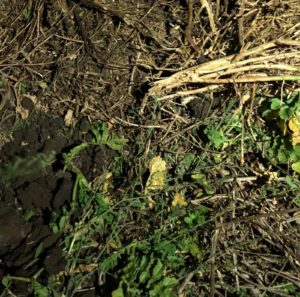
Site 2 Barellan (MS trial, minimal cropping): Trial site with minimal disturbance for 30+ years and no history of fertilisers or chemicals. Winter-cropped for 3 years (2018-2021). 12-way MS winter mix 2021, roller-crimped Sep 2021. MS summer 2021-22. Prone to flooding.
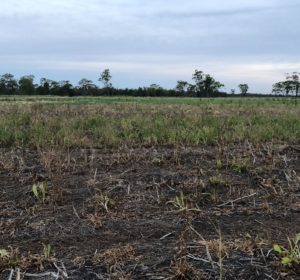
Site 3 Barellan (MS trial, long-term cropping): Trial site with history of monoculture and chemical use. A 12-way MS winter mix 2021 roller-crimped in Sep 2021. MS summer 2021-22 (sugardrip seed harvested). Planted wheat directly into MS regrowth winter 2022 (not harvested due to wet conditions).
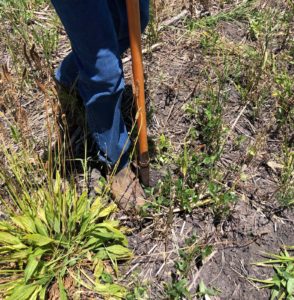
Site 4 Barellan (Typical cropping, minor practice change): History of monoculture cropping and chemical use with recent minor practice changes (modified herbicide use). Wheat 2022.
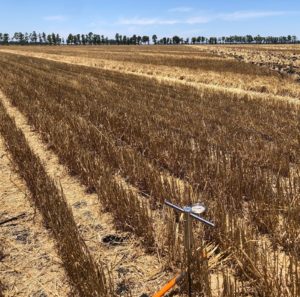
Site 5 Wysall Park (Typical cropping, high yield): Zero-tillage and high chemical inputs under previous management. This site has consistently high yields. Russell recently leased and planted the site to wheat in 2022.
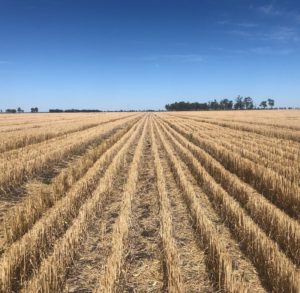
The other two sites were in the Jimbour region about a forty minute drive away:
Site 6 Avoca (Typical cropping, cereal crop): History of monoculture cropping and chemical use, with legumes in rotation. To ensure a full ‘profile’ of soil moisture prior to planting wheat, an 18-month fallow period was needed to shift from summer rotations to planting wheat, winter 2021 and 2022.
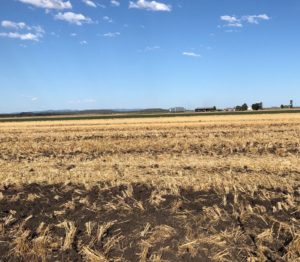
Site 7 Avoca (Typical cropping, legume then fallow): History of monoculture cropping and chemical use, with recent minor practice changes (soft rock phosphate). Wheat 2020, butterfly pea summer 2021-2022, and fallow winter 2022.
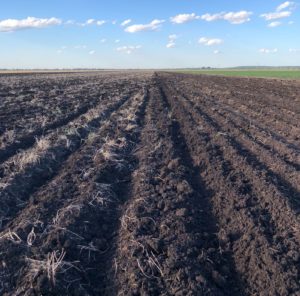
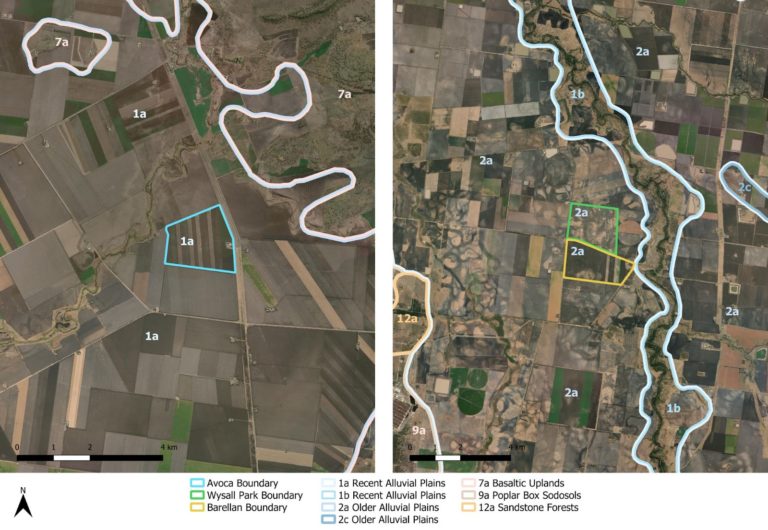
Figure 3. Satellite image of Young Seeds property boundaries, with overlays of the broad soil groups (Land Resource Areas) and the soil sampling sites selected by the Soils for Life team and Russell Young in November 2022. Source: Soils for Life. Note: The Land Resource Areas represent a regional overview and are not derived from detailed soil information.
Interpretation of soil test results
Soil is one of the most complex ecosystems on the planet. The three laboratory test suites have been chosen to provide complementary perspectives on soil health, and contain considerable information on soil chemistry, biology and functionality. However, soil tests represent a fraction of the complexity of the soil system at a single point in time – in this case, the samples were collected in December, when the temperatures were rising, winter crops had been harvested, and some of the summer crops had been planted following a very wet winter season.
Importantly, the comparative averages, guidelines and ranges referred to in this report reflect those provided in the laboratory-generated reports and are not necessarily specific to the farming property, region, soil characteristics, history and management goals.
Snapshots of the results from these tests are shown in Figure 4 below, and the full results are provided in Appendices A, B and C. Note: Each row of results has been coloured using a grey scale, where the lightest colour is the lowest number and the darkest colour is the highest number in the row. Colour coding does NOT indicate positive or negative results, and is merely provided to allow simple visual comparison of the numbers in each row. The results need to be interpreted with care (repeated testing over time is necessary to produce reliable insights and trends).
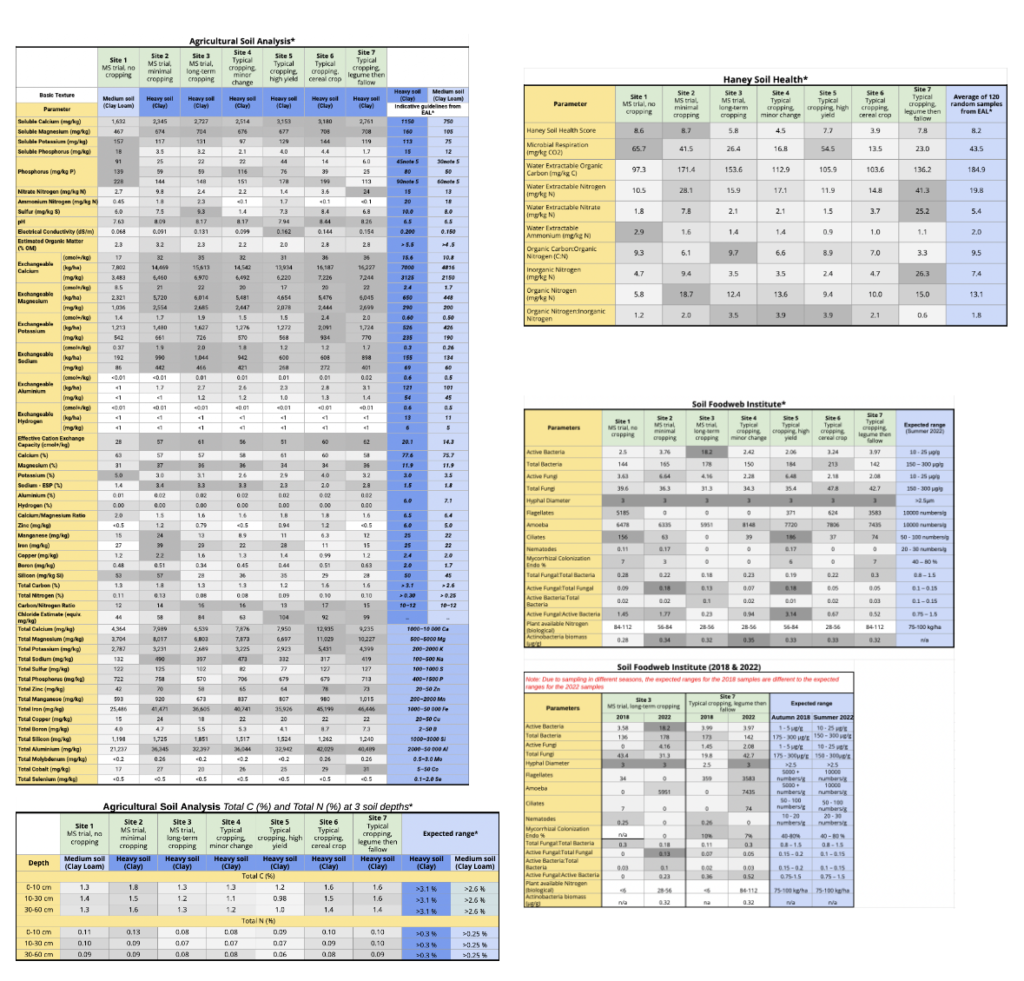
Figure 4. Snapshots of results from Young Seeds soil tests. Source: EAL; Soil Foodweb Institute; Soils for Life. See Appendices A, B and C for full detail.
- Soil health at the multispecies trial sites is improving. In particular, there were good water extractable carbon to nitrogen and water extractable organic to inorganic nitrogen ratios5See Haney test results in Appendix B..
- The three multispecies trial sites had moderate biological communities, with greater aggregate stability (based on slake testing) than all of the typical cropping sites. This is likely a result of reduced tillage, increased plant diversity and elimination of herbicide.
- Based on comparisons of soil tests from 2018 and 2022, multispecies cropping has had an impact on the size of microbial communities.. There was a significant increase in the microbial communities at site 3 following the introduction of the multispecies trial6 See Soil Foodweb Institute test results in Appendix C.. In part, this would be a result of the shift from dry conditions in 2018 to wet in 2022, but is also likely to be influenced by changes in land management.
- Results at sites with minimal practice change (typical cropping, frequent tilling and chemical use) generally indicate bacteria-dominant communities, and this is reflected by the low active fungal to active bacteria ratio7 See Soil Foodweb test results in Appendix C..
- The alkaline clay soils tested have high Effective Cation Exchange Capacity that could be further balanced, and low organic matter levels that need to be lifted.
- The available and total chemistry results – when viewed together – help in understanding the accessibility of nutrients necessary for the optimal function and interaction between the soil, microbe and plant systems8 See Agricultural Soil Analysis test results in Appendix A.. Supplying micro-nutrients in the system, particularly boron, zinc and molybdenum, could help to address deficiencies identified by the tests.
- Several of the typical cropping sites have results that reflect either too little water extractable organic carbon and/or too much water extractable organic nitrogen, which indicates an imbalance of energy and food. The soil would benefit from an increase in carbon inputs as the soil biology is currently burning up too much carbon9 See Haney test results in Appendix B..
- Site 7 was sampled in the fallow period following a legume rotation and this site held high levels of nitrogen in its inorganic form. Ratios of organic nitrogen to inorganic nitrogen of less than one are more volatile and susceptible to either leaching and surface runoff, or becoming immobilised (unavailable to plants) in the biological community. Improved nitrogen use efficiency could be achieved by rotation into a cereal crop or a carbon-dominant companion or multispeciesThere’s value in exploring puzzling or unusual phenomena on a farm. For example, site 5 has had consistently high yields and has the highest active fungal to active bacteria community. Higher active fungal to bacterial ratios are generally positive for cropping systems, and exploring crop. Improving nitrogen use efficiency can support functionality in the system and save money through reduction of inputs.
- There’s value in exploring puzzling or unusual phenomena on a farm. For example, site 5 has had consistently high yields and has the highest active fungal to active bacteria community10 See Soil Foodweb Institute test results in Appendix.. Higher active fungal to bacterial ratios are generally positive for cropping systems, and exploring the factors behind the levels on site 5 could inform future management.
Deeper Insights - Farmer and farm
Personal and family outcomes
To explore farmers’ perception of change in their personal relationships over time, Soils for Life created a wellbeing survey of six themes with associated indicators (Table 4)11This wellbeing survey combines questions from four sources: the Regional Wellbeing Survey (University of Canberra); Vanguard Business Services ‘People Perspective’ survey; Regenerative pillars (For the Love of Soil, Nicole Masters); and the personal Wellbeing Index 11 (Australian Centre on Quality of Life, 2020). The Wellbeing Index 11 indicators – used by researchers (Schirmer, Yabsley, Mylek, & Peel, 2016) and in the long-term broadscale Regional Wellbeing Survey conducted by the University of Canberra (2020) – are considered important for holistically measuring the sustainability of farming systems (Brown et al., 2021). . Farmers ranked each of these indicators, across all four phases, on a seven point scale from: very unhappy (1); unhappy (2); mostly dissatisfied (3); mixed (4); mostly satisfied (5); pleased (6); to very pleased (7). We then averaged the indicators to graph the ‘theme averages’ and observe their relative change over time, across the four phases (Figure 5). We also indicate below where any specific indicators are outliers in comparison to the general trend of other indicators in its theme.
Table 4. The six themes and indicators of personal relationships in the wellbeing survey.
| Relationships with: | Indicators |
| Self |
|
| Family |
|
| Friends and community |
|
| Farming |
|
| Land |
|
| Life |
|
The response to the wellbeing survey illustrates that during the period of practice change at Young Seeds (2016 – 2023), Russell felt consistently mostly satisfied with his relationships to life, farming, family and friends/community. His steady response to the survey questions (Figure 5), may reflect Russell’s commitment to the practice change process and to working through challenges on the farm. His steady and positive response might also reflect his self-described solid work ethic, open-mindedness, curiosity and willingness to learn new things, as he states:
I don’t have the answers right now, but if you don’t try new things, you don’t learn new things, and it’s a journey you go on. I’m happy to do it. I like to try new things. I think a lot of people do, but I guess some people are scared to because maybe it’s a failure in the eyes of people around them. I don’t know. But I’ve never let that worry me, you know? So, you just have a crack and see what happens.
Since making practice changes, Russell has experienced an improved relationship with himself. In the beginning, he had mixed feelings, which may correspond with the lack of control he felt over his own decision making at the time. Presumably through taking action about the direction of the farm, claiming agency over his own decisions, and building his confidence in practice change, his sense of health and his ability and time for self-care have improved, and he is now pleased with his situation.
Russell’s relationship with the land also improved over time (Figure 5). Observations of change (i.e. good aggregation of soil in Russell’s multispecies crops and noticeable improvements in moisture use efficiency) have provided positive feedback loops between Russell and his land, which have likely shifted his sense of connection to land from mixed feelings to feeling pleased.
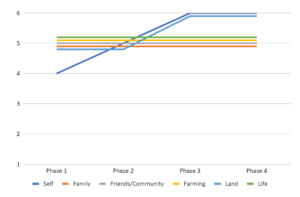
Figure 5. The line chart shows Russell Young’s response to the wellbeing survey responses across the four phases of practice change at Young Seeds (2016 – 2023) (where 1 denotes very unhappy and 7 denotes very happy). Source: Soils for Life.
Business outlook
Russell’s overall economic strategy is to strike a balance between investing in new innovations in the short-term while maintaining profitability over the long term, saying:
I don’t have a problem if we drop a little bit of overall profit because along the way, that probably actually also involves less use of equipment and some of those things, which is a cost that I wouldn’t have been looking at initially.
Accounting for the financial performance of Young Seeds at this stage of practice change is limited for a few reasons. Firstly, Russell has chosen to take a staged approach, beginning in 2017 and it is therefore difficult to determine significant trends over time. Secondly, because the trial site is relatively small (17 ha), the current output from the multispecies crop for example, represents a fraction of Young Seeds production.
Russell has eliminated the use of herbicide in the multispecies trial sites and reduced herbicide use across the whole farm by adding biologicals with chemical applications to improve chemical efficiency, reducing the amount of chemical required and reducing the impact on soil organisms. These changes have led to an overall reduction of herbicide use for his business by 10%.
Motivated by the 10% reduction in herbicide, Russell is keen to experiment with further reductions, but he plans to do this incrementally to ensure he can manage any impacts on yield. Importantly for soil health, the reduction in herbicide with the addition of biologicals is helping with chemical efficacy, thus reducing their impact on soil organisms.
There has been a strong economic imperative for Russell to wean the farm off expensive inputs because the overall cost has been increasing in recent years. This has been a real driver for Russell, along with other factors. When considering future uncertainties, Russell likes the idea of being relatively independent and self-reliant, particularly in relation to global price hikes and shocks. He wonders:
What happens if the boats of fertilizer and chemicals don’t come this way? What happens if they go somewhere else, because there’s more demand somewhere else or whatever. Or for some government reason they say, no, you can’t have this much in the country anymore. What are we all going to do then?
Looking ahead, Russell wants ‘to see dollar value for nutritional value’ in regenerative practice. This is how Russell can justify the additional work and resources involved. Otherwise, he says, ‘there is not enough incentive to go down this path other than for the obvious benefits to soil and getting away from chemical inputs’. Russell is watching markets to see if they are opening up for regenerative seed products. Based on his current observations, there is a lack of market interest and appetite in the regenerative product he is offering, however he is pretty confident this will change over the next 10 years, stating:
I think the regen farming space will only make it at the point where there’s a market for a better-quality grain, as in nutrient dense, almost like the organic market is. When regen gets to that point where a farmer who grows a crop can market it as a value-added crop or a value-added grain because of the way it’s grown, and there’s already a market there for it.
Industry leaders are supporting Russell in driving this issue and he hopes to be value adding to all of his seed and selling in smaller consignments when there is dollar value to the offering ‘over and above the standard dollar value’ of his current product.
Production output and quality outcomes
At this stage Russell has some concerns about the viability of multispecies cropping given that Youngs Seeds are 100% grain production (with certain lines of seed going to the seed market as value-add, namely wheat, barley, butterfly pea, cowpea and sugar drip). The Youngs need a cash crop component each harvest to remain economical.
There is growing potential to promote lines that can go into multispecies markets, as either 1) single species, or 2) combined species. To develop this area of business, he needs to be able to sort and grade multispecies seeds, and if a ‘sensible market’ opens up for multispecies mixes in the region, Russell would happily grow and market this seed. Currently buyers don’t ask him questions about protein or nutritional content, and instead the focus is on grain purity. Until he sees market changes, it will be hard for Russell to sell a differentiated product that people recognise, but as Russell says, ‘hopefully there are some markets out there’ and he is motivated to discover them.
Testing the nutritional density of his own regeneratively grown product is something that Russell has wanted to do since beginning to make changes to practice, including benchmarking to establish what he can improve year-on-year. Like many farmers, Russell is interested in the potential for new markets where he can sell better-quality, nutrient-dense grain. He has participated in a pilot nutritional study into the nutrient content of Young Seeds grain samples. Stay tuned for further information on this pilot study as we continue to explore relationships between soil health and the food produced, nutrient content of crops, and nutrition as a way to value and open up markets for regenerative farming.
Appendices - Soil test results
Appendix A. Young Seeds Agricultural Soil Results
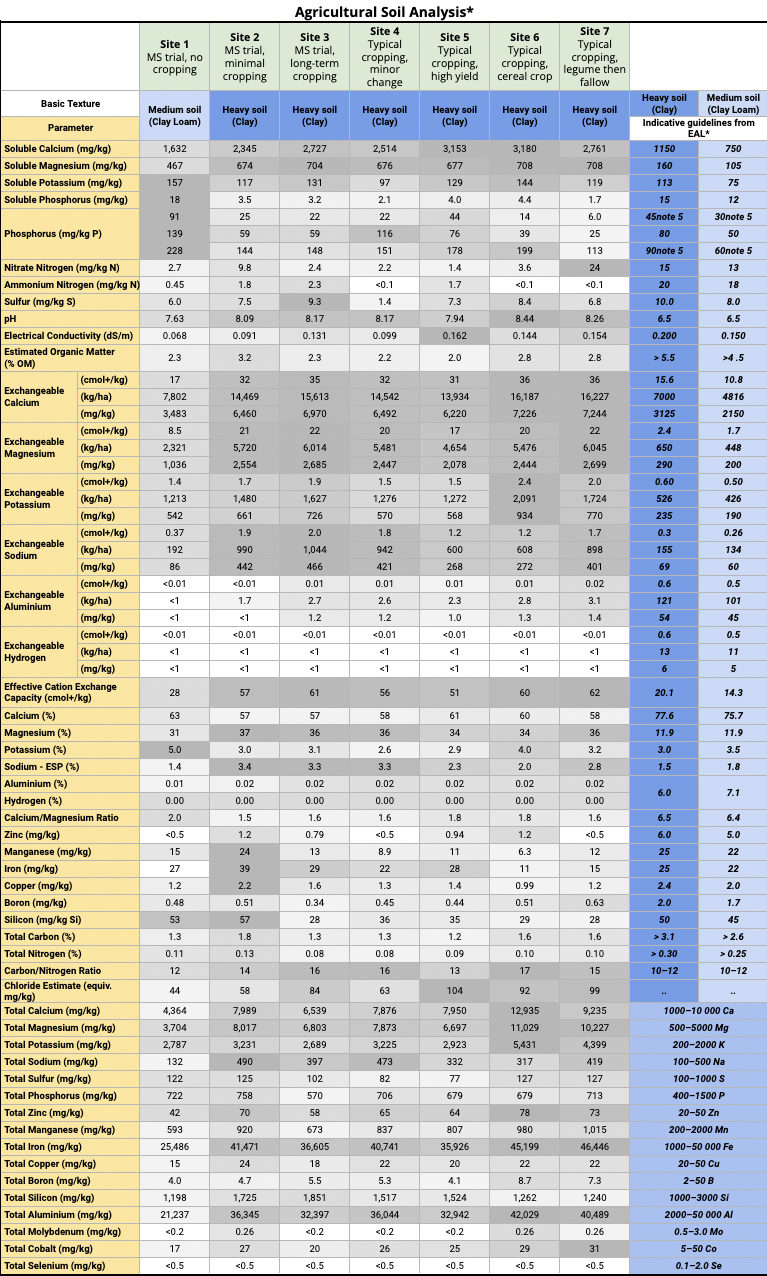
Appendix A. Young Seeds Agricultural Soil Results (continued)

Appendix B. Young Seeds Haney Soil Health Results
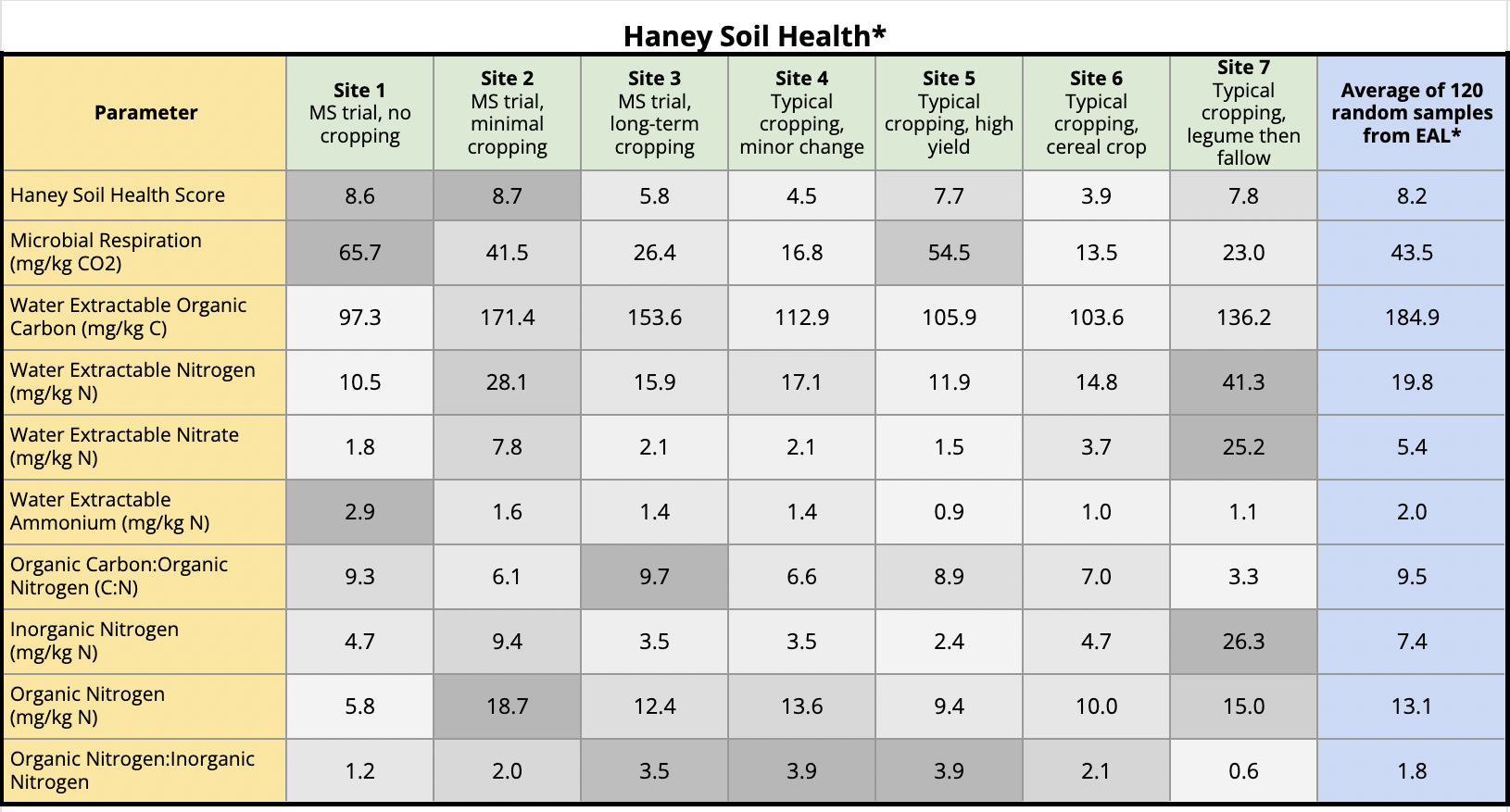
Appendix C. Young Seeds Soil Foodweb Institute Results

* More detail on Soil Foodweb Institute Australia’s tests here.
Appendices A, B & C: Each row of results has been coloured using a grey scale, where the lightest colour is the lowest number and the darkest colour is the highest number in the row. Colour coding does NOT indicate positive or negative results, and is merely provided to allow simple visual comparison of the numbers in each row.
References
Australian Centre on Quality of Life (2020) Personal Wellbeing Index. Retrieved from <https://www.acqol.com.au/instruments#measures>.
Brown K, Schirmer J and Upton P (2021) ‘Regenerative farming and human wellbeing: Are subjective wellbeing measures useful indicators for sustainable farming systems?’ Environmental and Sustainability Indicators, 11(100132): https://doi.org/10.1016/j.indic.2021.100132
Harris PS, Biggs AJW and Stone BJ (eds) (1999) Central Darling Downs Land Management Manual. Department of Natural Resources, Queensland. DNR 990102.
Isbell RF and the National Committee on Soil and Terrain (NCST) (2021) The Australian Soil Classification (Third edit). CSIRO Publishing, Melbourne.
Masters N (2019) For the Love of Soil: Strategies to Regenerate our Food Production System, Integrity Soils, USA.
Regional Wellbeing Survey (RWS) (2020) The University of Canberra. Retrieved from <https://www.regionalwellbeing.org.au/project/regional-wellbeing-survey-user-guide/>.
Schirmer J, Yabsley B, Mylek M, and Peel D (2016) ‘Wellbeing, resilience and liveability in regional Australia: The 2015 Regional Wellbeing Survey’, University of Canberra, Canberra.
Full Reports
External Links
Your Questions
Do you have questions or feedback? We’d love to know more about you and your needs around our case study reports, get in touch.
To hear the latest, follow us on social media or subscribe to our newsletter.
This project is supported by the Australian Government’s Smart Farms Program.





